Manganese-Iron Phosphate Nodules at the Groken Site, Gale Crater, Mars
Abstract
1. Introduction
| Designation | Name | Description | Figure |
|---|---|---|---|
| Formation | Carolyn Shoemaker | Sandstones and mudstones transitional from lacustrine to fluvial systems | Figure 1A and Figure 2 |
| Member | Knockfarrill Hill | In Carolyn Shoemaker formation, dominated by finely laminated and cross-bedded sandstones | Figure 1B and Figure 2 |
| Outcrop | Falkirk_Wheel | Bedrock slab in Knockfarrill Hill member, east of Mozie_Law. | |
| Site | Wart | Nodule-rich layer on Falkirk_Wheel. | |
| Outcrop | Le_Ceasnachadh | Float rock, with dark nodular surface. | |
| Outcrop | Mozie_Law | Bedrock slab in Knockfarrill Hill member. | Figure 1B and Figure 3A |
| Site | Mary_Anning | Drill location on Mozie_Law; sample analyzed by CheMin & SAM | Figure 2 and Figure 3A |
| Site | Mary_Anning2 | Drill location on Mozie_Law; sample analyzed by SAM | |
| Site | Mary_Anning3 | Drill location on Mozie_Law; sample analyzed by CheMin & SAM | Figure 2 and Figure 3A |
| Site | Groken | Drill location on Mozie_Law targeted to collect dark nodule material; sample analyzed by CheMin & SAM | Figure 2 and Figure 3 |
| Site | Trow | MAHLI/APXS targets on Mozie_Law near Ayton, imaged at 5 cm standoff with dust cover closed | Figure 3B |
| Site | Ayton | Three APXS targets on Mozie_Law near Groken, analyzed to deconvolve the composition of dark nodules | Figure 3B |
| Site | Ballalan | Site near Mary_Anning3 on Mozie_Law, MALHI image showing scattered small nodules | Figure 3E |
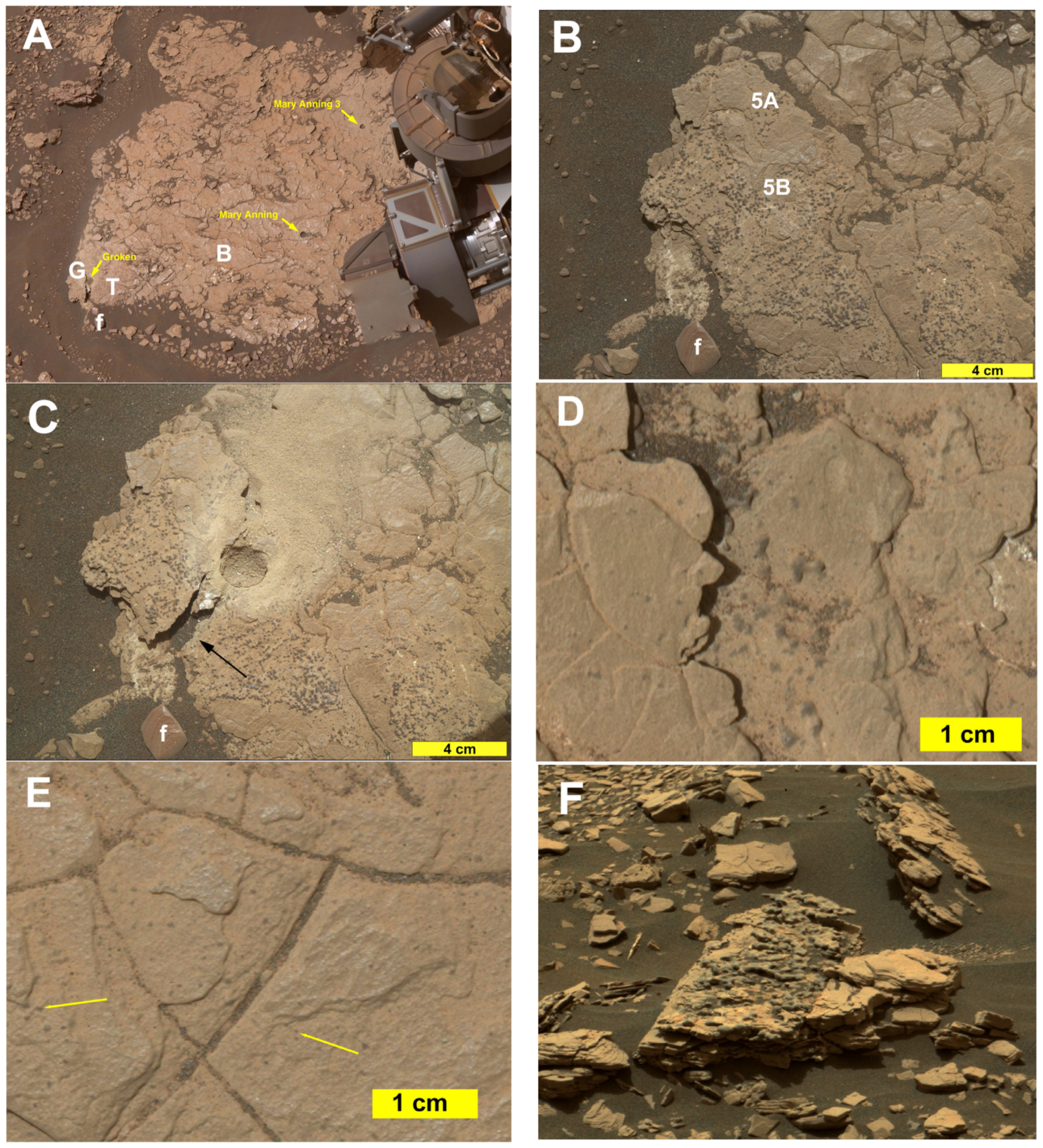
2. Data and Methods
2.1. Imaging
2.1.1. Mastcam
2.1.2. MAHLI
2.1.3. NCAM
2.1.4. Digital Outcrop Modelling
2.2. Elemental Chemistry
2.2.1. APXS
2.2.2. ChemCam—LIBS
2.3. Reflectance Spectra
2.3.1. ChemCam Passive
2.3.2. Mastcam Multispectral
2.4. CheMin
2.5. SAM
2.6. Drill
2.7. Mineral Stabilities
3. Results
3.1. Local Geology
3.2. Rock Surface
3.2.1. APXS
3.2.2. LIBS
3.2.3. Reflectance
3.3. Drilled Sample—Minimal Nodule Material
3.3.1. CheMin X-ray Diffraction
3.3.2. CheMin X-ray Fluorescence
3.3.3. SAM
3.3.4. Reflectance Spectra
3.3.5. Drill Engineering Data
3.3.6. Nodule Material in the Groken Drill Sample?
3.4. Summary: What Are the Nodules Now?
3.4.1. Geology
3.4.2. Drill Sample—Minimal Nodule Material
3.4.3. Mineralogy
3.4.4. Chemical Composition
4. Discussion: What Were the Nodules Originally?
4.1. Precursor Mineral: Molar P/Mn = 2
4.1.1. Laueite/Strunzite
4.1.2. Aqueous Solution Model
4.2. Precursor to Laueite And/Or Strunzite?
4.3. Conditions for Vivianite Crystallization
4.3.1. Elemental Mobility and Sources
4.3.2. Carbonaceous Matter?
4.3.3. Vivianite as a Cement
4.3.4. Localization
5. Implications: Speculative History
Supplementary Materials
Author Contributions
Funding
Data Availability Statement
Acknowledgments
Conflicts of Interest
References
- Grotzinger, J.P.; Crisp, J.; Vasavada, A.R.; Anderson, R.C.; Baker, C.J.; Barry, R.; Blake, D.F.; Conrad, P.; Edgett, K.S.; Ferdowski, B. Mars Science Laboratory mission and science investigation. Space Sci. Rev. 2012, 170, 5–56. [Google Scholar]
- Grotzinger, J.P.; Crisp, J.A.; Vasavada, A.R. Curiosity’s mission of exploration at Gale Crater, Mars. Elements 2015, 11, 19–26. [Google Scholar]
- Vasavada, A.R. Mission overview and scientific contributions from the Mars Science Laboratory Curiosity rover after eight years of surface operations. Space Sci. Rev. 2022, 218, 14. [Google Scholar]
- Grotzinger, J.P.; Sumner, D.; Kah, L.; Stack, K.; Gupta, S.; Edgar, L.; Rubin, D.; Lewis, K.; Schieber, J.; Mangold, N. A habitable fluvio-lacustrine environment at Yellowknife Bay, Gale Crater, Mars. Science 2014, 343, 1242777. [Google Scholar]
- Grotzinger, J.P.; Gupta, S.; Malin, M.C.; Rubin, A.E.; Schieber, J.; Siebach, K.; Sumner, D.Y.; Stack, K.M.; Vasavada, A.R.; Arvidson, R.; et al. Deposition, exhumation, and paleoclimate of an ancient lake deposit, Gale Crater, Mars. Science 2015, 350, acc7575. [Google Scholar] [CrossRef]
- Stein, N.; Grotzinger, J.; Schieber, J.; Mangold, N.; Hallet, B.; Newsom, H.; Stack, K.; Berger, J.; Thompson, L.; Siebach, K. Desiccation cracks provide evidence of lake drying on Mars, Sutton Island member, Murray formation, Gale Crater. Geology 2018, 46, 515–518. [Google Scholar]
- Caravaca, G.; Mangold, N.; Dehouck, E.; Schieber, J.; Zaugg, L.; Bryk, A.B.; Fedo, C.M.; Le Mouélic, S.; Le Deit, L.; Banham, S.G. From lake to river: Documenting an environmental transition across the Jura/Knockfarril Hill members boundary in the Glen Torridon region of Gale Crater (Mars). J. Geophys. Res. Planets 2022, 127, e2021JE007093. [Google Scholar]
- Gasda, P.J.; Comellas, J.; Essunfeld, A.; Das, D.; Bryk, A.B.; Dehouck, E.; Schwenzer, S.P.; Crossey, L.; Herkenhoff, K.; Johnson, J. Overview of the morphology and chemistry of diagenetic features in the clay-rich Glen Torridon unit of Gale Crater, Mars. J. Geophys. Res. Planets 2022, 127, e2021JE007097. [Google Scholar]
- Edgar, L.; Rubin, D.; Schieber, J.; Gupta, S.; Williams, R.; Stack, K.; Rice, M.; Grotzinger, J.; Lewis, K.; Malin, M. Reconstructing ancient fluvial environments at the Balmville and Dingo Gap outcrops, Gale crater, Mars; American Geophysical Union: Washington, DC, USA, 2014; p. P42C-05. [Google Scholar]
- Nachon, M.; Clegg, S.; Mangold, N.; Schröder, S.; Kah, L.; Dromart, G.; Ollila, A.; Johnson, J.; Oehler, D.; Bridges, J. Calcium sulfate veins characterized by ChemCam/Curiosity at Gale crater, Mars. J. Geophys. Res. Planets 2014, 119, 1991–2016. [Google Scholar]
- Stack, K.; Grotzinger, J.; Kah, L.; Schmidt, M.; Mangold, N.; Edgett, K.; Sumner, D.; Siebach, K.; Nachon, M.; Lee, R. Diagenetic origin of nodules in the Sheepbed member, Yellowknife Bay formation, Gale crater, Mars. J. Geophys. Res. Planets 2014, 119, 1637–1664. [Google Scholar]
- Blaney, D.; Wiens, R.; Maurice, S.; Clegg, S.; Anderson, R.; Kah, L.; Le Mouelic, S.; Ollila, A.; Bridges, N.; Tokar, R. Chemistry and texture of the rocks at Rocknest, Gale Crater: Evidence for sedimentary origin and diagenetic alteration. J. Geophys. Res. Planets 2014, 119, 2109–2131. [Google Scholar]
- Siebach, K.; Grotzinger, J.; McLennan, S.; Hurowitz, J.; Ming, D.; Vaniman, D.; Rampe, E.; Blaney, D.; Kah, L. Constraining the texture and composition of pore-filling cements at Gale crater, Mars. In Proceedings of the Lunar and Planetary Science Conference 46th, The Woodlands, TX, USA, 16–20 March 2015; p. 2234. [Google Scholar]
- Schwenzer, S.P.; Bridges, J.C.; Wiens, R.C.; Conrad, P.G.; Kelley, S.; Leveille, R.; Mangold, N.; Martín-Torres, J.; McAdam, A.; Newsom, H. Fluids during diagenesis and sulfate vein formation in sediments at Gale crater, Mars. Meteorit. Planet. Sci. 2016, 51, 2175–2202. [Google Scholar]
- Le Deit, L.; Mangold, N.; Forni, O.; Cousin, A.; Lasue, J.; Schröder, S.; Weins, R.C.; Sumner, D.; Fabre, C.; Stack, K.M.; et al. The potassic sedimentary rocks in Gale crater, Mars as seen by ChemCam onboard Curiosity. J. Geophys. Res. 2016, 121, 784–804. [Google Scholar] [CrossRef]
- Sun, V.Z.; Stack, K.M.; Kah, L.C.; Thompson, L.; Fischer, W.; Williams, A.J.; Johnson, S.S.; Wiens, R.C.; Kronyak, R.E.; Nachon, M. Late-stage diagenetic concretions in the Murray formation, Gale crater, Mars. Icarus 2019, 321, 866–890. [Google Scholar]
- Rampe, E.B.; Blake, D.F.; Bristow, T.; Ming, D.W.; Vaniman, D.; Morris, R.; Achilles, C.; Chipera, S.; Morrison, S.; Tu, V. Mineralogy and geochemistry of sedimentary rocks and eolian sediments in Gale crater, Mars: A review after six Earth years of exploration with Curiosity. Geochemistry 2020, 80, 125605. [Google Scholar]
- Fraeman, A.A.; Edgar, L.A.; Rampe, E.B.; Thompson, L.M.; Frydenvang, J.; Fedo, C.M.; Catalano, J.G.; Dietrich, W.E.; Gabriel, T.S.; Vasavada, A. Evidence for a diagenetic origin of Vera Rubin ridge, Gale crater, Mars: Summary and synthesis of Curiosity’s exploration campaign. J. Geophys. Res. Planets 2020, 125, e2020JE006527. [Google Scholar]
- Caravaca, G.; Le Mouélic, S.; Mangold, N.; L’Haridon, J.; Le Deit, L.; Massé, M. 3D digital outcrop model reconstruction of the Kimberley outcrop (Gale Crater, Mars) and its integration into virtual reality for simulated geological analysis. Planet. Space Sci. 2020, 182, 104808. [Google Scholar]
- David, G.; Cousin, A.; Forni, O.; Meslin, P.Y.; Dehouck, E.; Mangold, N.; L’Haridon, J.; Rapin, W.; Gasnault, O.; Johnson, J. Analyses of high-iron sedimentary bedrock and diagenetic features observed with ChemCam at Vera Rubin ridge, Gale crater, Mars: Calibration and characterization. J. Geophys. Res. Planets 2020, 125, e2019JE006314. [Google Scholar]
- Bristow, T.; Grotzinger, J.P.; Rampe, E.; Cuadros, J.; Chipera, S.; Downs, G.; Fedo, C.M.; Frydenvang, J.; McAdam, A.; Morris, R. Brine-driven destruction of clay minerals in Gale crater, Mars. Science 2021, 373, 198–204. [Google Scholar]
- Sutter, B.; McAdam, A.; Wong, G.; Clark, J.; Archer, P.; Franz, H.; Gasda, P.; Ming, D.; Yen, A.; Lewis, J. Constraining alteration processes along the Siccar Point Group unconformity, Gale Crater, Mars: Results from the Sample Analysis at Mars instrument. J. Geophys. Res. Planets 2022, 127, e2022JE007387. [Google Scholar]
- Rampe, E.; Ming, D.; Morris, R.; Blake, D.; Bristow, T.; SJ, C.; Vaniman, D.; Yen, A.; Grotzinger, J.; Downs, R. Diagenesis in the Murray formation, Gale Crater, mM. Lunar Planet. Sci. Conf. 2016, 47, 2543. [Google Scholar]
- Yen, A.S.; Ming, D.W.; Vaniman, D.T.; Gellert, R.; Blake, D.F.; Morris, R.V.; Morrison, S.M.; Bristow, T.F.; Chipera, S.J.; Edgett, K.S. Multiple stages of aqueous alteration along fractures in mudstone and sandstone strata in Gale Crater, Mars. Earth Planet. Sci. Lett. 2017, 471, 186–198. [Google Scholar]
- Meslin, P.-Y.; Gasda, P.; L’Haridon, J.; Forni, O.; Lanza, N.; Lamm, S.; Johnson, J.; Wiens, R.; Thompson, L.; Rapin, W. Detection of hydrous manganese and iron oxides with variable phosphorus and magnesium contents in the lacustrine sediments of the Murray Formation, Gale, Mars. Lunar Planet. Sci. Conf. 2018, 49, 1447. [Google Scholar]
- Berger, J.A.; King, P.L.; Gellert, R.; Clark, B.C.; Flood, V.A.; McCraig, M.A.; Ming, D.W.; O’Connell-Cooper, C.D.; Schmidt, M.E.; Thompson, L.M.; et al. Manganese mobility in Gale Crater, Mars: Leached bdrock and localized enrichments. J. Geophys. Res. Planets 2022, 127, e2021JE00717. [Google Scholar] [CrossRef]
- Meslin, P.-Y.; Forni, O.; Loche, M.; Fabre, S.; Lanza, N.; Gasda, P.; Treiman, A.; Berger, J.; Cousin, A.; Gasnault, O. Overview of secondary phosphate facies observed by Chemcam in Gale Crater, Mars. EGU Gen. Assem. Conf. 2022, 2022, EGU22-6613. [Google Scholar]
- Berger, J.A.; Gellert, R.; Boyd, N.I.; King, P.L.; McCraig, M.A.; O’Connell-Cooper, C.D.; Schmidt, M.E.; Spray, J.G.; Thompson, L.M.; VanBommel, S.J. Elemental composition and chemical evolution of geologic materials in Gale Crater, Mars: APXS results from Bradbury landing to the Vera Rubin ridge. J. Geophys. Res. Planets 2020, 125, e2020JE006536. [Google Scholar]
- L’Haridon, J.; Mangold, N.; Meslin, P.-Y.; Johnson, J.; Rapin, W.; Forni, O.; Cousin, A.; Payré, V.; Dehouck, E.; Nachon, M. Chemical variability in mineralized veins observed by ChemCam on the lower slopes of Mount Sharp in Gale crater, Mars. Icarus 2018, 311, 69–86. [Google Scholar]
- Johnson, J.E.; Webb, S.M.; Thomas, K.; Ono, S.; Kirschvink, J.L.; Fischer, W.W. Manganese-oxidizing photosynthesis before the rise of cyanobacteria. Proc. Natl. Acad. Sci. USA 2013, 110, 11238–11243. [Google Scholar]
- Lingappa, U.F.; Yeager, C.M.; Sharma, A.; Lanza, N.L.; Morales, D.P.; Xie, G.; Atencio, A.D.; Chadwick, G.L.; Monteverde, D.R.; Magyar, J.S. An ecophysiological explanation for manganese enrichment in rock varnish. Proc. Natl. Acad. Sci. USA 2021, 118, e2025188118. [Google Scholar]
- Bennett, K.A.; Fox, V.K.; Bryk, A.; Dietrich, W.; Fedo, C.; Edgar, L.; Thorpe, M.T.; Williams, A.J.; Wong, G.M.; Dehouck, E. The Curiosity Rover’s exploration of Glen Torridon, Gale crater, Mars: An overview of the campaign and scientific results. J. Geophys. Res. Planets 2023, 128, e2022JE007185. [Google Scholar] [PubMed]
- Thompson, L.M.; Berger, J.A.; Spray, J.G.; Fraeman, A.A.; McCraig, M.A.; O’Connell-Cooper, C.; Schmidt, M.E.; VanBommel, S.J.; Gellert, R.; Yen, A.; et al. APXS-derived compositional characteristics of the Vera Rubin Ridge, Gale crater, Mars: Geochemical implications for the origin of the ridge. J. Geophys. Res. Planets 2020, 125, e2019JE006319. [Google Scholar]
- Dehouck, E.; Cousin, A.; Mangold, N.; Frydenvang, J.; Gasnault, O.; Forni, O.; Rapin, W.; Gasda, P.J.; Caravaca, G.; David, G. Bedrock geochemistry and alteration history of the clay-bearing Glen Torridon region of Gale crater, Mars. J. Geophys. Res. Planets 2022, 127, e2021JE007103. [Google Scholar]
- Cardenas, B.T.; Grotzinger, J.P.; Lamb, M.P.; Lewis, K.W.; Fedo, C.M.; Bryk, A.B.; Dietrich, W.E.; Stein, N.; Turner, M.; Caravaca, G. Barform deposits of the Carolyn Shoemaker formation, Gale crater, Mars. J. Sediment. Res. 2022, 92, 1071–1092. [Google Scholar]
- Thorpe, M.T.; Bristow, T.F.; Rampe, E.B.; Tosca, N.J.; Grotzinger, J.P.; Bennett, K.; Achilles, C.N.; Blake, D.F.; Chipera, S.; Downs, G.; et al. Mars Science Laboratory CheMin data from the Glen Torridon region and the significance of lake-groundwater interactions in interpreting mineralogy and sedimentary history. J. Geophys. Res. Planets 2022, 127, e2021JE007099. [Google Scholar]
- Malin, M.C.; Ravine, M.A.; Caplinger, M.A.; Tony Ghaemi, F.; Schaffner, J.A.; Maki, J.N.; Bell III, J.F.; Cameron, J.F.; Dietrich, W.E.; Edgett, K.S. The Mars Science Laboratory (MSL) mast cameras and descent imager: Investigation and instrument descriptions. Earth Space Sci. 2017, 4, 506–539. [Google Scholar]
- Bell III, J.F.; Godber, A.; McNair, S.; Caplinger, M.; Maki, J.; Lemmon, M.; Van Beek, J.; Malin, M.; Wellington, D.; Kinch, K. The Mars Science Laboratory Curiosity rover Mastcam instruments: Preflight and in-flight calibration, validation, and data archiving. Earth Space Sci. 2017, 4, 396–452. [Google Scholar] [CrossRef]
- Edgett, K.S.; Yingst, R.A.; Ravine, M.A.; Caplinger, M.A.; Maki, J.N.; Ghaemi, F.T.; Schaffner, J.A.; Bell, J.F.; Edwards, L.J.; Herkenhoff, K.E. Curiosity’s Mars hand lens imager (MAHLI) investigation. Space Sci. Rev. 2012, 170, 259–317. [Google Scholar]
- VanBommel, S.J.; Berger, J.A.; Gellert, R.; O’Connell-Cooper, C.D.; McCraig, M.A.; Thompson, L.M.; Fedo, C.M.; Des Marais, D.J.; Fey, D.M.; Yen, A.S.; et al. Elemental composition of manganese- and phosphorus-rich nodules in the Knockfarril Hill member, Gale Crater, Mars. Icarus 2023, 392, 115372. [Google Scholar]
- Gellert, R.; Clark, B.C. In-situ compositional measurements of rocks and soils with the Alpha Particle X-ray Spectrometer on NASA’s Mars rovers. Elements 2015, 11, 39–44. [Google Scholar] [CrossRef]
- Campbell, J.L.; Perrett, G.M.; Gellert, R.; Andrushenko, S.M.; Boyd, N.I.; Maxwell, J.A.; King, P.L.; Schofield, C.D. Calibration of the Mars Science Laboratory Alpha Particle X-ray Spectrometer. Space Sci. Rev. 2012, 170, 319–340. [Google Scholar] [CrossRef]
- VanBommel, S.J.; Gellert, R.; Berger, J.A.; Campbell, J.L.; Thompson, L.M.; Edgett, K.S.; McBride, M.J.; Minitti, M.E.; Pradler, I.; Boyd, N.I. Deconvolution of distinct lithology chemistry through oversampling with the Mars Science Laboratory Alpha Particle X-ray Spectrometer. X-ray Spectrom. 2016, 45, 155–161. [Google Scholar] [CrossRef]
- O’Connell-Cooper, C.D.; Thompson, L.M.; Spray, J.G.; Berger, J.A.; Gellert, R.; McCraig, M.; VanBommel, S.J.; Yen, A. Statistical analysis of APXS-derived chemistry of the clay-bearing Glen Torridon region and Mount Sharp group, Gale crater, Mars. J. Geophys. Res. Planets 2022, 127, e2021JE007177. [Google Scholar] [CrossRef]
- VanBommel, S.J.; Gellert, R.; Berger, J.; McCraig, M.; O’Connell-Cooper, C.; Thompson, L.; Yen, A.; Boyd, N.; Lanza, N.; Ollila, A. Constraining the chemical depth profile of a manganese-rich surface layer in Gale crater, Mars. Spectrochim. Acta Part B At. Spectrosc. 2022, 191, 106410. [Google Scholar] [CrossRef]
- Maurice, S.; Wiens, R.; Saccoccio, M.; Barraclough, B.; Gasnault, O.; Forni, O.; Mangold, N.; Baratoux, D.; Bender, S.; Berger, G.; et al. The ChemCam instrument suite on the Mars Science Laboratory (MSL) rover: Science objectives and mast unit description. Space Sci. Rev. 2012, 170, 95–166. [Google Scholar] [CrossRef]
- Wiens, R.C.; Maurice, S.; Barraclough, B.; Saccoccio, M.; Barkley, W.C.; Bell III, J.F.; Bender, S.; Bernardin, J.; Blaney, D.; Blank, J.; et al. The ChemCam instrument suite on the Mars Science Laboratory (MSL) rover: Body unit and combined system tests. Space Sci. Rev. 2012, 170, 167–227. [Google Scholar] [CrossRef]
- Chide, B.; Maurice, S.; Murdoch, N.; Lasue, J.; Bousquet, B.; Jacob, X.; Cousin, A.; Forni, O.; Gasnault, O.; Meslin, P.-Y. Listening to laser sparks: A link between Laser-Induced Breakdown Spectroscopy, acoustic measurements and crater morphology. Spectrochim. Acta Part B At. Spectrosc. 2019, 153, 50–60. [Google Scholar] [CrossRef]
- Wiens, R.C.; Maurice, S.; Lasue, J.; Forni, O.; Anderson, R.; Clegg, S.; Bender, S.; Blaney, D.; Barraclough, B.; Cousin, A. Pre-flight calibration and initial data processing for the ChemCam laser-induced breakdown spectroscopy instrument on the Mars Science Laboratory rover. Spectrochim. Acta Part B At. Spectrosc. 2013, 82, 1–27. [Google Scholar] [CrossRef]
- Clegg, S.M.; Wiens, R.C.; Anderson, R.; Forni, O.; Frydenvang, J.; Lasue, J.; Cousin, A.; Payré, V.; Boucher, T.; Dyar, M.D. Recalibration of the Mars Science Laboratory ChemCam instrument with an expanded geochemical database. Spectrochim. Acta Part B At. Spectrosc. 2017, 129, 64–85. [Google Scholar] [CrossRef]
- Gasda, P.J.; Anderson, R.B.; Cousin, A.; Forni, O.; Clegg, S.M.; Ollila, A.; Lanza, N.; Frydenvang, J.; Lamm, S.; Wiens, R.C. Quantification of manganese for ChemCam Mars and laboratory spectra using a multivariate model. Spectrochim. Acta Part B At. Spectrosc. 2021, 181, 106223. [Google Scholar] [CrossRef]
- Payré, V.; Cousin, A.; Anderson, D.E.; Thomas, N.H.; Rapin, W.; Beck, P.; Fabre, C.; Gasda, P.J.; Lasue, J.; Ollila, A.M.; et al. Review of trace and minor elements analyzed by ChemCam: Detection and quantification using laser induced breakdown spectroscopy. Lunar Planet. Sci. Conf. 2017, 48, 1963. [Google Scholar]
- Maurice, S.; Clegg, S.M.; Wiens, R.C.; Gasnault, O.; Rapin, W.; Forni, O.; Cousin, A.; Sautter, V.; Mangold, N.; Le Deit, L. ChemCam activities and discoveries during the nominal mission of the Mars Science Laboratory in Gale crater, Mars. J. Anal. At. Spectrom. 2016, 31, 863–889. [Google Scholar] [CrossRef]
- Payré, V.; Fabre, C.; Cousin, A.; Sautter, V.; Wiens, R.C.; Forni, O.; Gasnault, O.; Mangold, N.; Meslin, P.Y.; Lasue, J. Alkali trace elements in Gale crater, Mars, with ChemCam: Calibration update and geological implications. J. Geophys. Res. Planets 2017, 122, 650–679. [Google Scholar] [CrossRef]
- Johnson, J.R.; Bell III, J.; Bender, S.; Blaney, D.; Cloutis, E.; DeFlores, L.; Ehlmann, B.; Gasnault, O.; Gondet, B.; Kinch, K. ChemCam passive reflectance spectroscopy of surface materials at the Curiosity landing site, Mars. Icarus 2015, 249, 74–92. [Google Scholar] [CrossRef]
- Johnson, J.R.; Bell III, J.F.; Bender, S.; Blaney, D.; Cloutis, E.; Ehlmann, B.; Fraeman, A.; Gasnault, O.; Kinch, K.; Le Mouélic, S. Constraints on iron sulfate and iron oxide mineralogy from ChemCam visible/near-infrared reflectance spectroscopy of Mt. Sharp basal units, Gale Crater, Mars. Am. Mineral. 2016, 101, 1501–1514. [Google Scholar] [CrossRef]
- Fox, V.; Arvidson, R.; Jolliff, B.; Carpenter, P.; Catalano, J.; Hinkle, M.; Morris, R. Characterization of synthetic and natural manganese oxides as martian analogues. Lunar Planet. Sci. Conf. 2015, 46, 2132. [Google Scholar]
- Xin, Y.; Cao, H.; Liu, C.; Chen, J.; Liu, P.; Lu, Y.; Ling, Z. A systematic spectroscopic study of laboratory synthesized manganese oxides relevant to Mars. J. Raman Spectrosc. 2021, 53, 340–355. [Google Scholar] [CrossRef]
- Haber, J.T.; Horgan, B.; Fraeman, A.A.; Johnson, J.R.; Bell III, J.F.; Rice, M.S.; Seeger, C.; Mangold, N.; Thompson, L.; Wellington, D. Mineralogy of a possible ancient lakeshore in the Sutton Island member of Mt. Sharp, Gale crater, Mars, from Mastcam multispectral images. J. Geophys. Res. Planets 2022, 127, e2022JE007357. [Google Scholar] [CrossRef]
- Rice, M.S.; Seeger, C.; Bell, J.; Calef, F.; St. Clair, M.; Eng, A.; Fraeman, A.A.; Hughes, C.; Horgan, B.; Jacob, S. Spectral diversity of rocks and soils in Mastcam observations along the Curiosity rover’s traverse in Gale Crater, Mars. J. Geophys. Res. Planets 2022, 127, e2021JE007134. [Google Scholar] [CrossRef]
- Blake, D.F.; Vaniman, D.T.; Achilles, C.N.; Anderson, R.; Bish, D.L.; Bristow, T.F.; Chen, C.; Chipera, S.J.; Crisp, J.A.; Des Marais, D.; et al. Characterization and calibration of the CheMin mineralogical instrument on Mars Science Laboratory. Space Sci. Rev. 2012, 170, 341–399. [Google Scholar] [CrossRef]
- Anderson, R.C.; Jandura, L.; Okon, A.B.; Sunshine, D.; Roumeliotis, C.; Beegle, L.W.; Hurowitz, J.A.; Kennedy, B.; Limonadi, D.; McCloskey, S.; et al. Collecting samples in Gale Crater, Mars; An overview of the Mars Science Laboratory Sample Acquisition, Sample Processing and Handling System. Space Sci. Rev. 2012, 170, 57–75. [Google Scholar] [CrossRef]
- Morrison, S.M.; Downs, R.T.; Blake, D.F.; Prabhu, A.; Eleish, A.; Vaniman, D.T.; Ming, D.W.; Rampe, E.B.; Hazen, R.M.; Achilles, C.N. Relationships between unit-cell parameters and composition for rock-forming minerals on Earth, Mars, and other extraterrestrial bodies. Am. Mineral. 2018, 103, 848–856. [Google Scholar] [CrossRef]
- Mahaffy, P.R.; Webster, C.R.; Cabane, M.; Conrad, P.G.; Coll, P.; Atreya, S.K.; Arvey, R.; Barciniak, M.; Benna, M.; Bleacher, L. The Sample Analysis at Mars investigation and instrument suite. Space Sci. Rev. 2012, 170, 401–478. [Google Scholar] [CrossRef]
- McAdam, A.; Sutter, B.; Archer, P.; Franz, H.; Wong, G.; Lewis, J.; Clark, J.; Millan, M.; Williams, A.; Eigenbrode, J. Evolved gas analyses of sedimentary rocks from the Glen Torridon Clay-Bearing Unit, Gale crater, Mars: Results from the Mars Science Laboratory Sample Analysis at Mars Instrument Suite. J. Geophys. Res. Planets 2022, 127, e2022JE007179. [Google Scholar] [CrossRef]
- Millan, M.; Williams, A.J.; Mcadam, A.C.; Eigenbrode, J.L.; Steele, A.; Freissinet, C.; Glavin, D.P.; Szopa, C.; Buch, A.; Summons, R.E. Sedimentary organics in Glen Torridon, Gale Crater, Mars: Results from the SAM instrument suite and supporting laboratory analyses. J. Geophys. Res. Planets 2022, 127, e2021JE007107. [Google Scholar] [CrossRef]
- Verma, V.; Carsten, J.; Kuhn, S. The evolution of the Curiosity rover sampling chain. J. Field Robot. 2020, 37, 729–753. [Google Scholar] [CrossRef]
- Kinnett, R.; Green, T.; Klein, D.; Lin, M.R. Remote diagnosis and operational response to an in-flight failure of the drill feed mechanism onboard the Mars Science Laboratory Rover. In Proceedings of the 46th Aerospace Mechanisms Symposium, NASA Johnson Space Center, Houston, TX, USA, 13 May 2022; pp. 309–322. [Google Scholar]
- Bethke, C.M. Geochemical and Biogeochemical Reaction Modeling; Cambridge University Press: Cambridge, UK, 2022; p. 543. [Google Scholar]
- Vieillard, P.; Tardy, Y. Thermochemical properties of phosphates. In Phosphate Minerals; Springer: Berlin/Heidelberg, Germany, 1984; pp. 171–198. [Google Scholar]
- Drouet, C.; Loche, M.; Fabre, S.; Meslin, P.-Y. On the occurrence of jahnsite/whiteite phases on Mars: A thermodynamic study. Am. Mineral. 2022, 107, 1807–1817. [Google Scholar] [CrossRef]
- Nriagu, J.O.; Dell, C. Diagenetic formation of iron phosphates in recent lake sediments. Am. Mineral. 1974, 59, 934–946. [Google Scholar]
- Loche, M.; Fabre, S.; Meslin, P.-Y.; Cousin, A.; Lanza, N.; Kah, L.; Gasnault, O.; Maurice, S.; Wiens, R. Exploring the formation of the Mn-P-Fe-Mg enrichment of the Groken nodules in Gale Crater with source-to-sink geochemical modeling. Lunar Planet. Sci. Conf. 2022, 53, 1274. [Google Scholar]
- Drouet, C. A comprehensive guide to experimental and predicted thermodynamic properties of phosphate apatite minerals in view of applicative purposes. J. Chem. Thermodyn. 2015, 81, 143–159. [Google Scholar] [CrossRef]
- Drouet, C. Applied predictive thermodynamics (ThermAP). Part 2. Apatites containing Ni2+, Co2+, Mn2+, or Fe2+ ions. J. Chem. Thermodyn. 2019, 136, 182–189. [Google Scholar] [CrossRef]
- Hallet, B.; Sletten, R.S.; Malin, M.; Mangold, N.; Sullivan, R.J.; Fairén, A.G.; Martínez, G.; Baker, M.; Schieber, J.; Martin-Torres, J. Active ground patterns near Mars’ equator in the Glen Torridon region of Gale Crater. J. Geophys. Res. Planets 2022, 127, e2021JE007126. [Google Scholar] [CrossRef]
- Kah, L.C.; Stack, K.M.; Eigenbrode, J.L.; Yingst, R.A.; Edgett, K.E. Syndepositional precipitation of calcium sulfate in Gale Crater, Mars. Terra Nova 2018, 30, 431–439. [Google Scholar] [CrossRef]
- Kronyak, R.E.; Kah, L.; Edgett, K.; VanBommel, S.; Thompson, L.; Wiens, R.; Sun, V.; Nachon, M. Mineral-filled fractures as indicators of multigenerational fluid flow in the Pahrump Hills member of the Murray formation, Gale crater, Mars. Earth Space Sci. 2019, 6, 238–265. [Google Scholar] [CrossRef]
- Hansen, P.B. Modeling of LIBS Spectra Obtained in Martian Atmospheric Conditions; Humboldt University of Berlin: Berlin, Germany, 2022. [Google Scholar]
- Schröder, S.; Rammelkamp, K.; Hansen, P.B.; Seel, F.; Cousin, A.; Forni, O.; Gasnault, O.; Meslin, P.-Y.; Pilleri, P.; Rapin, W.; et al. Semiquantitative analysis of ChemCam and SuperCam LIBS data with spectral unmixing. Lunar Planet. Sci. Conf. 2023, 54, 2014. [Google Scholar]
- Kokaly, R.F.; Clark, R.N.; Swayze, G.A.; Livo, K.E.; Hoefen, T.M.; Pearson, N.C.; Wise, R.A.; Benzel, W.M.; Lowers, H.A.; Driscoll, R.L.; et al. USGS Spectral Library Version 7; U.S. Geological Survey Data Series; U.S. Geological Survey: Reston, VA, USA, 2017; Volume 1035.
- Farrand, W.H.; Johnson, J.R.; Rice, M.S.; Wang, A.; Bell III, J.F. VNIR multispectral observations of aqueous alteration materials by the Pancams on the Spirit and Opportunity Mars Exploration Rovers. Am. Mineral. 2016, 101, 2005–2019. [Google Scholar] [CrossRef]
- Lanza, N.L.; Wiens, R.C.; Arvidson, R.E.; Clark, B.C.; Fischer, W.W.; Gellert, R.; Grotzinger, J.P.; Hurowitz, J.A.; McLennan, S.M.; Morris, R.V. Oxidation of manganese in an ancient aquifer, Kimberley formation, Gale crater, Mars. Geophys. Res. Lett. 2016, 43, 7398–7407. [Google Scholar] [CrossRef]
- Tu, V.M.; Rampe, E.B.; Bristow, T.F.; Thorpe, M.T.; Clark, J.V.; Castle, N.; Fraeman, A.A.; Edgar, L.A.; McAdam, A.; Bedford, C. A review of the phyllosilicates in Gale Crater as detected by the CheMin instrument on the Mars Science Laboratory, Curiosity rover. Minerals 2021, 11, 847. [Google Scholar] [CrossRef]
- Smith, R.; McLennan, S.; Achilles, C.; Dehouck, E.; Horgan, B.; Mangold, N.; Rampe, E.; Salvatore, M.; Siebach, K.; Sun, V. X-Ray amorphous components in sedimentary rocks of Gale Crater, Mars: Evidence for ancient formation and long-lived aqueous activity. J. Geophys. Res. Planets 2021, 126, e2020JE006782. [Google Scholar] [CrossRef]
- Treiman, A.; Downs, R.; Ming, D.; Morris, R.; Thorpe, M.; Hazen, R.; Downs, G.; Rampe, E.; CheMin Team, T. Possible detection of a jahnsite-whiteite group phosphate mineral by MSL CheMin in Glen Torridon, Gale Crater, Mars. Lunar Planet. Sci. Conf. 2021, 52, 1200. [Google Scholar]
- Brangule, A.; Gross, K.; Komarovska, L.; Vīksna, A. Exploring zinc apatites through different synthesis routes. Key Eng. Mater. 2014, 587, 171–176. [Google Scholar] [CrossRef]
- Vecbiskena, L.; Gross, K.A.; Riekstina, U.; Yang, T.C.-K. Crystallized nano-sized alpha-tricalcium phosphate from amorphous calcium phosphate: Microstructure, cementation and cell response. Biomed. Mater. 2015, 10, 025009. [Google Scholar] [CrossRef] [PubMed]
- Rodgers, K.; Henderson, G. The thermochemistry of some iron phosphate minerals: Vivianite, metavivianite, baraćite, ludlamite and vivianite/metavivianite admixtures. Thermochim. Acta 1986, 104, 1–12. [Google Scholar] [CrossRef]
- Chukanov, N.V.; Scholz, R.; Zubkova, N.V.; Pekov, I.V.; Belakovskiy, D.I.; Van, K.V.; Lagoeiro, L.; Graça, L.M.; Krambrock, K.; de Oliveira, L.C. Correianevesite, Fe2+Mn22+(PO4)2·3H2O, a new reddingite-group mineral from the Cigana mine, Conselheiro Pena, Minas Gerais, Brazil. Am. Mineral. 2014, 99, 811–816. [Google Scholar] [CrossRef]
- Kubeneck, L.J.; Thomas-Arrigo, L.K.; Rothwell, K.A.; Kaegi, R.; Kretzschmar, R. Competitive incorporation of Mn and Mg in vivianite at varying salinity and effects on crystal structure and morphology. Geochim. Cosmochim. Acta 2023, 346, 231–244. [Google Scholar] [CrossRef]
- Kulik, D.A.; Kersten, M.; Heiser, U.; Neumann, T. Application of Gibbs energy minimization to model early-diagenetic solid-solution aqueous-solution equilibria involving authigenic rhodochrosites in Anoxic Baltic Sea sediments. Aquat. Geochem. 2000, 6, 147–199. [Google Scholar] [CrossRef]
- Glynn, P. Solid-solution solubilities and thermodynamics: Sulfates, carbonates and halides. Rev. Mineral. Geochem. 2000, 40, 481–511. [Google Scholar] [CrossRef]
- Vinograd, V.L.; Winkler, B.; Putnis, A.; Gale, J.D.; Sluiter, M.H. Static lattice energy calculations of mixing and ordering enthalpy in binary carbonate solid solutions. Chem. Geol. 2006, 225, 304–313. [Google Scholar] [CrossRef]
- Redfern, S.A.; Knight, K.; Henderson, C.; Wood, B. Fe-Mn cation ordering in fayalite–tephroite (FexMn1−x)2SiO4 olivines: A neutron diffraction study. Mineral. Mag. 1998, 62, 607–615. [Google Scholar] [CrossRef]
- Anthony, J.W.; Bideaux, R.A.; Bladh, K.W.; Nichols, M.C. Handbook of Mineralogy; Mineralogical Society of America: Chantilly, VA, USA, 2023; Available online: http://www.handbookofmineralogy.org/ (accessed on 7 July 2023).
- Whittaker, E.; Muntus, R. Ionic radii for use in geochemistry. Geochim. Et Cosmochim. Acta 1970, 34, 945–956. [Google Scholar] [CrossRef]
- Güven, N. Smectites. In Hydrous Phyllosilicates (Exclusive of Micas); Reviews in Mineralogy; Bailey, S.W., Ribbe, P.H., Eds.; Mineralogical Society of America: Washington, DC, USA, 1988; pp. 497–559. [Google Scholar]
- Strunz, H. Laueit, MnFe23+[OH/PO4]2·8H2O, ein neues Mineral. Naturwissenschaften 1954, 41, 256. [Google Scholar] [CrossRef]
- Frondel, C. Strunzite, a new mineral. Naturwissenschaften 1958, 45, 37–38. [Google Scholar] [CrossRef]
- Azam, H.M.; Alam, S.T.; Hasan, M.; Yameogo, D.D.S.; Kannan, A.D.; Rahman, A.; Kwon, M.J. Phosphorous in the environment: Characteristics with distribution and effects, removal mechanisms, treatment technologies, and factors affecting recovery as minerals in natural and engineered systems. Environ. Sci. Pollut. Res. Int. 2019, 26, 20183–20207. [Google Scholar] [CrossRef] [PubMed]
- Matsubara, S. Vivianite nodules and secondary phosphates in Pliocene-Pleistocene clay deposits from Hime-Shima, Oita Prefecture and Kobe, Hyogo Prefecture, western Japan. Mem Natl. Sci Mus Tokyo 2000, 33, 15–27. [Google Scholar]
- Dill, H.G.; Weber, B.; Kaufhold, S. The origin of siderite-goethite-phosphate mineralization in the karst-related faultbound iron ore deposit Auerbach, Germany, a clue to the timing of hypogene and supergene Fe-Al phosphates in NE Bavaria. Neues Jahrb. Für Mineral.-Abh. 2009, 186, 283–307. [Google Scholar]
- Fernández-Remolar, D.; Sánchez-Román, M.; Hill, A.C.; Gómez-Ortíz, D.; Ballesteros, O.P.; Romanek, C.S.; Amils, R. The environment of early Mars and the missing carbonates. Meteorit. Planet. Sci. 2011, 46, 1447–1469. [Google Scholar] [CrossRef]
- Bridges, J.C.; Hicks, L.J.; Treiman, A.H. Carbonates on Mars. In Volatiles in the Martian Crust; Filiberto, J., Schwenzer, S.P., Eds.; Elsevier: Amsterdam, The Netherlands, 2019; pp. 89–118. [Google Scholar]
- Cullen, M.; Phillips-Lander, C.; Madden, A.E.; Madden, M.E. Siderite dissolution in Mars-analog Brines: Kinetics and reaction products. Planet. Sci. J. 2021, 2, 169. [Google Scholar] [CrossRef]
- Nakano, S. Manganoan vivianite in the bottom sediments of Lake Biwa, Japan. Mineral. J. 1992, 16, 96–107. [Google Scholar] [CrossRef]
- Friedl, G.; Wehrli, B.; Manceau, A. Solid phases in the cycling of manganese in eutrophic lakes: New insights from EXAFS spectroscopy. Geochim. Cosmochim. Acta 1997, 61, 275–290. [Google Scholar] [CrossRef]
- Egger, M.; Jilbert, T.; Behrends, T.; Rivard, C.; Slomp, C.P. Vivianite is a major sink for phosphorus in methanogenic coastal surface sediments. Geochim. Cosmochim. Acta 2015, 169, 217–235. [Google Scholar] [CrossRef]
- Makri, S.; Wienhues, G.; Bigalke, M.; Gilli, A.; Rey, F.; Tinner, W.; Vogel, H.; Grosjean, M. Variations of sedimentary Fe and Mn fractions under changing lake mixing regimes, oxygenation and land surface processes during Late-glacial and Holocene times. Sci. Total Environ. 2021, 755, 143418. [Google Scholar] [CrossRef]
- Vuillemin, A.; Friese, A.; Wirth, R.; Schuessler, J.A.; Schleicher, A.M.; Kemnitz, H.; Lücke, A.; Bauer, K.W.; Nomosatryo, S.; Von Blanckenburg, F. Vivianite formation in ferruginous sediments from Lake Towuti, Indonesia. Biogeosciences 2020, 17, 1955–1973. [Google Scholar] [CrossRef]
- Cosmidis, J.; Benzerara, K.; Morin, G.; Busigny, V.; Lebeau, O.; Jézéquel, D.; Noël, V.; Dublet, G.; Othmane, G. Biomineralization of iron-phosphates in the water column of Lake Pavin (Massif Central, France). Geochim. Cosmochim. Acta 2014, 126, 78–96. [Google Scholar] [CrossRef]
- Barth, T.F. Crystallographic studies in the vivianite group. Am. Mineral. 1937, 22, 325–341. [Google Scholar]
- Rečnik, A. Minerals of the Mercury Ore Deposit Idria; Springer: Berlin/Heidelberg, Germany, 2013; p. 110. [Google Scholar]
- Madsen, H.E.L. Morphology and optical properties of precipitated vivianite, Fe3(PO4)2·8H2O. Cryst. Res. Technol. 2020, 55, 1900226. [Google Scholar] [CrossRef]
- Rudolph, A.; Horgan, B.; Johnson, J.; Bennett, K.; Haber, J.; Bell III, J.; Fox, V.; Jacob, S.; Maurice, S.; Rampe, E. The distribution of clay minerals and their impact on diagenesis in Glen Torridon, Gale crater, Mars. J. Geophys. Res. Planets 2022, 127, e2021JE007098. [Google Scholar] [CrossRef]
- Lanza, N.; Gasda, P.; Swanner, E.; Fischer, W.; Treiman, A.; Essunfeld, A.; Comellas, J.; Williams, A.; Rampe, E.; Meslin, P.-Y. Precipitation of Mn-bearing nodules in a shallow shoreline environment in Gale Crater, Mars. Lunar Planet. Sci. Conf. 2022, 53, 2689. [Google Scholar]
- Ruzicka, A.; Snyder, G.A.; Taylor, L.A. Comparative geochemistry of basalts from the Moon, Earth, HED asteroid, and Mars: Implications for the origin of the Moon. Geochim. Cosmochim. Acta 2001, 65, 979–997. [Google Scholar] [CrossRef]
- Berger, J.A.; Schmidt, M.E.; Gellert, R.; Boyd, N.I.; Desouza, E.D.; Flemming, R.L.; Izawa, M.R.; Ming, D.W.; Perrett, G.M.; Rampe, E.B. Zinc and germanium in the sedimentary rocks of Gale Crater on Mars indicate hydrothermal enrichment followed by diagenetic fractionation. J. Geophys. Res. Planets 2017, 122, 1747–1772. [Google Scholar] [CrossRef]
- Adcock, C.T.; Hausrath, E.M. Weathering profiles in phosphorus-rich rocks at Gusev Crater, Mars, suggest dissolution of phosphate minerals into potentially habitable near-neutral waters. Astrobiology 2015, 15, 1060–1075. [Google Scholar] [CrossRef] [PubMed]
- Adcock, C.T.; Hausrath, E.M.; Forster, P. Readily available phosphate from minerals in early aqueous environments on Mars. Nat. Geosci. 2013, 6, 824–827. [Google Scholar] [CrossRef]
- Seeger, C.; Grotzinger, J.P.; Thompson, L.M.; Kah, L.C. Unpacking diagenetic overprints associated with the clay-sulfate transition in Gale crater, Mars. Geol. Soc. Am. Abstr. Programs 2021, 53, 2021AM–370244. [Google Scholar] [CrossRef]
- Tanaka, A.; Seyama, H.; Soma, M. Iron and manganese-rich sediments as an indicator of hot spring activities at the bottom of Lake Mashu, Japan. Geochem. J. 1994, 28, 289–306. [Google Scholar] [CrossRef]
- Khan, M.A.; Kakar, M.I.; Ulrich, T.; Ali, L.; Kerr, A.C.; Mahmood, K.; Siddiqui, R.H. Genesis of manganese deposits in the Ali Khanzai block of the Zhob ophiolite, Pakistan: Inferences from geochemistry and mineralogy. J. Earth Sci. 2020, 31, 884–895. [Google Scholar] [CrossRef]
- Tumiati, S.; Martin, S.; Godard, G. Hydrothermal origin of manganese in the high-pressure ophiolite metasediments of Praborna ore deposit (Aosta Valley, Western Alps). Eur. J. Mineral. 2010, 22, 577–594. [Google Scholar] [CrossRef]
- Pinto-Auso, M.; Harper, G.D. Sedimentation, metallogenesis, and tectonic origin of the basal Galice Formation overlying the Josephine ophiolite, northwestern California. J. Geol. 1985, 93, 713–725. [Google Scholar] [CrossRef]
- Rothe, M.; Kleeberg, A.; Hupfer, M. The occurrence, identification and environmental relevance of vivianite in waterlogged soils and aquatic sediments. Earth-Sci. Rev. 2016, 158, 51–64. [Google Scholar] [CrossRef]
- Tessenow, U. Solution, diffusion and sorption in the upper layer of lake sediments. IV. Reaction mechanisms and equilibria in the system iron-manganese-phosphate with regard to the accumulation of vivianite in Lake Ursee. Arch. Hydrobiol. Suppl. 1974, 47, 1–79. [Google Scholar]
- Stoops, G. SEM and light microscopic observations of minerals in bog-ores of the Belgian Campine. In Developments in Soil Science; Elsevier: Amsterdam, The Netherlands, 1983; Volume 12, pp. 179–186. [Google Scholar]
- Henderson, G.; Black, P.; Rodgers, K.; Rankin, P. New data on New Zealand vivianite and metavivianite. N. Z. J. Geol. Geophys. 1984, 27, 367–378. [Google Scholar]
- Nanzyo, M.; Onodera, H.; Hasegawa, E.; Ito, K.; Kanno, H. Formation and dissolution of vivianite in paddy field soil. Soil Sci. Soc. Am. J. 2013, 77, 1452–1459. [Google Scholar] [CrossRef]
- Stamatakis, M.; Koukouzas, N. The occurrence of phosphate minerals in lacustrine clayey diatomite deposits, Thessaly, Central Greece. Sediment. Geol. 2001, 139, 33–47. [Google Scholar] [CrossRef]
- McGowan, G.; Prangnell, J. The significance of vivianite in archaeological settings. Geoarchaeology 2006, 21, 93–111. [Google Scholar] [CrossRef]
- Shannon, E.V. Description of vivianite encrusting a fossil tusk from gold placers of Clearwater County, Idaho. Proc. U. S. Natl. Mus. 1921, 59, 415–417. [Google Scholar] [CrossRef][Green Version]
- Thali, M.J.; Lux, B.; Lösch, S.; Rösing, F.W.; Hürlimann, J.; Feer, P.; Dirnhofer, R.; Königsdorfer, U.; Zollinger, U. “Brienzi”–The blue vivianite man of Switzerland: Time since death estimation of an adipocere body. Forensic Sci. Int. 2011, 211, 34–40. [Google Scholar] [CrossRef] [PubMed]
- Jafarzadeh, A.; Burnham, C. Gypsum crystals in soils. J. Soil Sci. 1992, 43, 409–420. [Google Scholar] [CrossRef]
- London, D. The barite roses of Oklahoma. Mineral. Rec. 2008, 39, 277–292. [Google Scholar]
- Rodgers, K. Some occurrences of vivianite in the Auckland area. N. Z. J. Geol. Geophys. 1977, 20, 363–367. [Google Scholar] [CrossRef]
- Noboru, H.; Shugo, O.; Satoshi, N. Interstitial vivianite and siderite-rhodochrosite in sandy nodules on a submerged terrace in Lake Biwa, Shiga Prefecture, Japan. Earth Sci. (Chikyu Kagaku) 2018, 72, 213–218. [Google Scholar]
- Ixer, R.A.; Tindle, A.G. An unusual magnesium-bearing vivianite within a sandstone hone from Canterbury, Kent. J. Russell Soc. 2020, 2020, 97. [Google Scholar]
- Dellwig, O.; Leipe, T.; März, C.; Glockzin, M.; Pollehne, F.; Schnetger, B.; Yakushev, E.V.; Böttcher, M.E.; Brumsack, H.-J. A new particulate Mn–Fe–P-shuttle at the redoxcline of anoxic basins. Geochim. Cosmochim. Acta 2010, 74, 7100–7115. [Google Scholar] [CrossRef]
- Jilbert, T.; Slomp, C.P. Iron and manganese shuttles control the formation of authigenic phosphorus minerals in the euxinic basins of the Baltic Sea. Geochim. Cosmochim. Acta 2013, 107, 155–169. [Google Scholar] [CrossRef]
- Dijkstra, N.; Hagens, M.; Egger, M.; Slomp, C.P. Post-depositional formation of vivianite-type minerals alters sediment phosphorus records. Biogeosciences 2018, 15, 861–883. [Google Scholar] [CrossRef]
- Hurowitz, J.A.; Grotzinger, J.P.; Fischer, W.W.; McLennan, S.M.; Milliken, R.E.; Stein, N.; Vasavada, A.R.; Blake, D.F.; Dehouck, E.; Eigenbrode, J.L. Redox stratification of an ancient lake in Gale crater, Mars. Science 2017, 356, eaah6849. [Google Scholar] [CrossRef] [PubMed]
- Schwid, M.F.; Xiao, S.; Hiatt, E.E.; Fang, Y.; Nolan, M.R. Iron phosphate in the Ediacaran Doushantuo Formation of South China: A previously undocumented marine phosphate sink. Palaeogeogr. Palaeoclimatol. Palaeoecol. 2020, 560, 109993. [Google Scholar] [CrossRef]
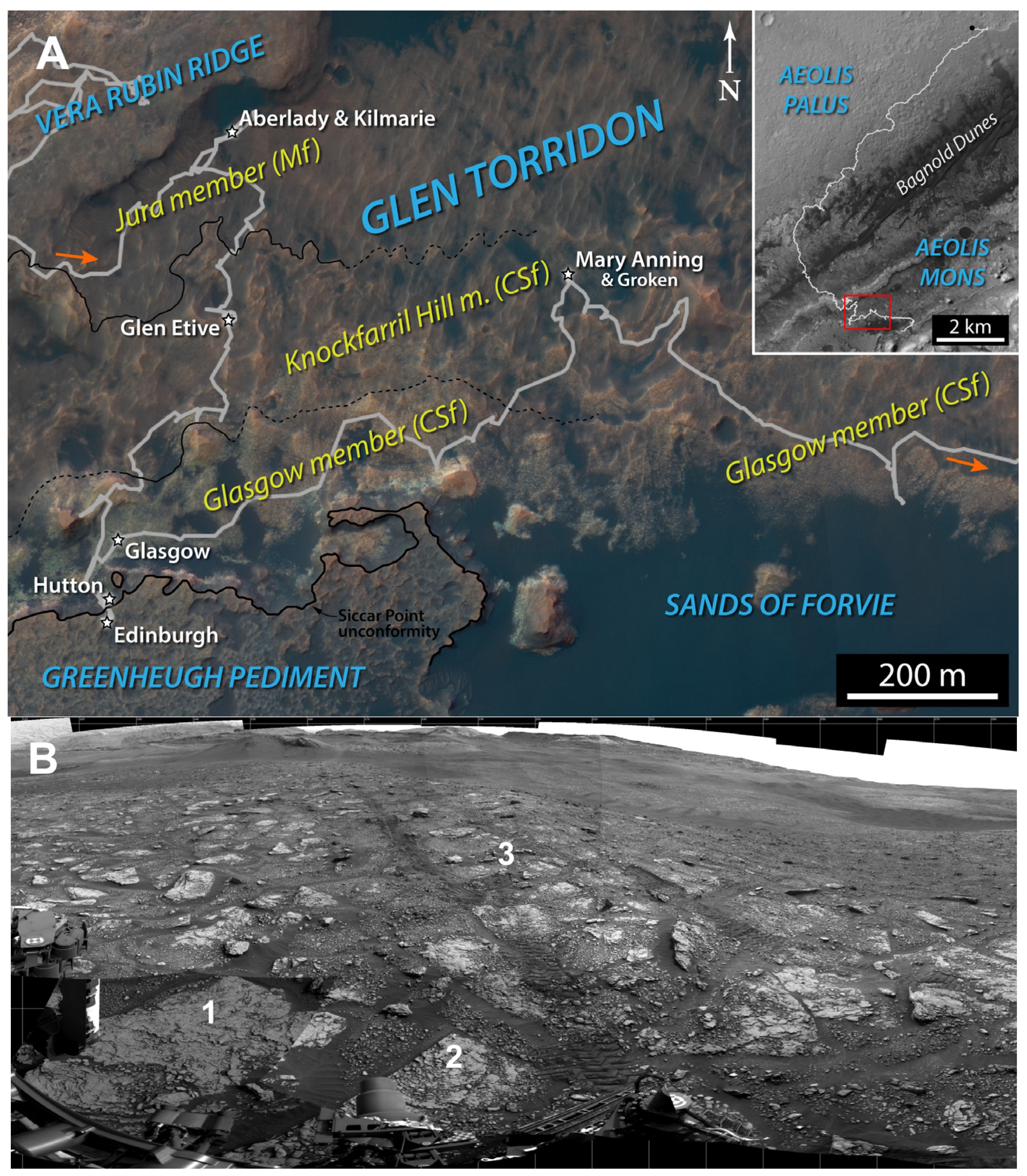
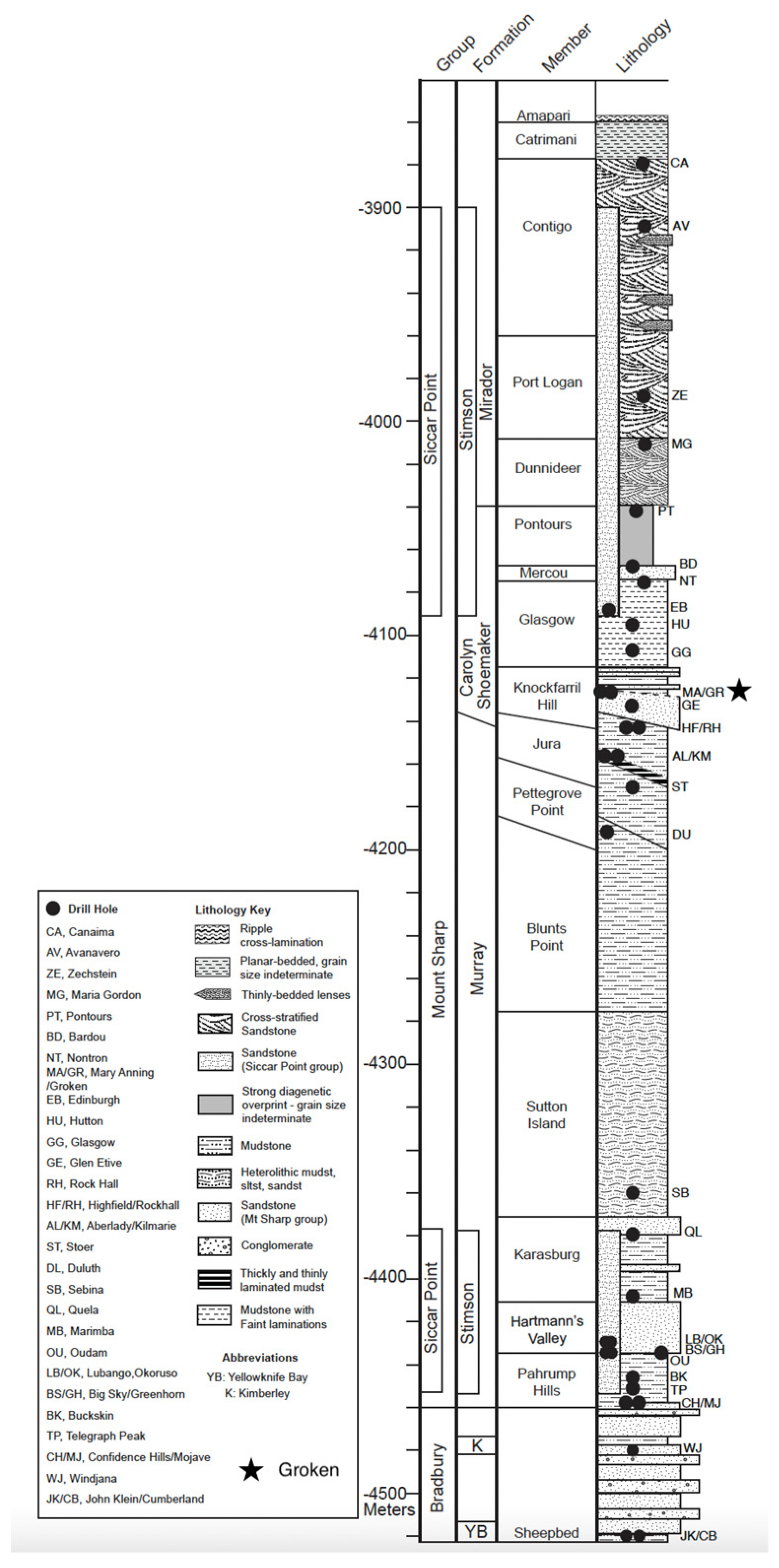
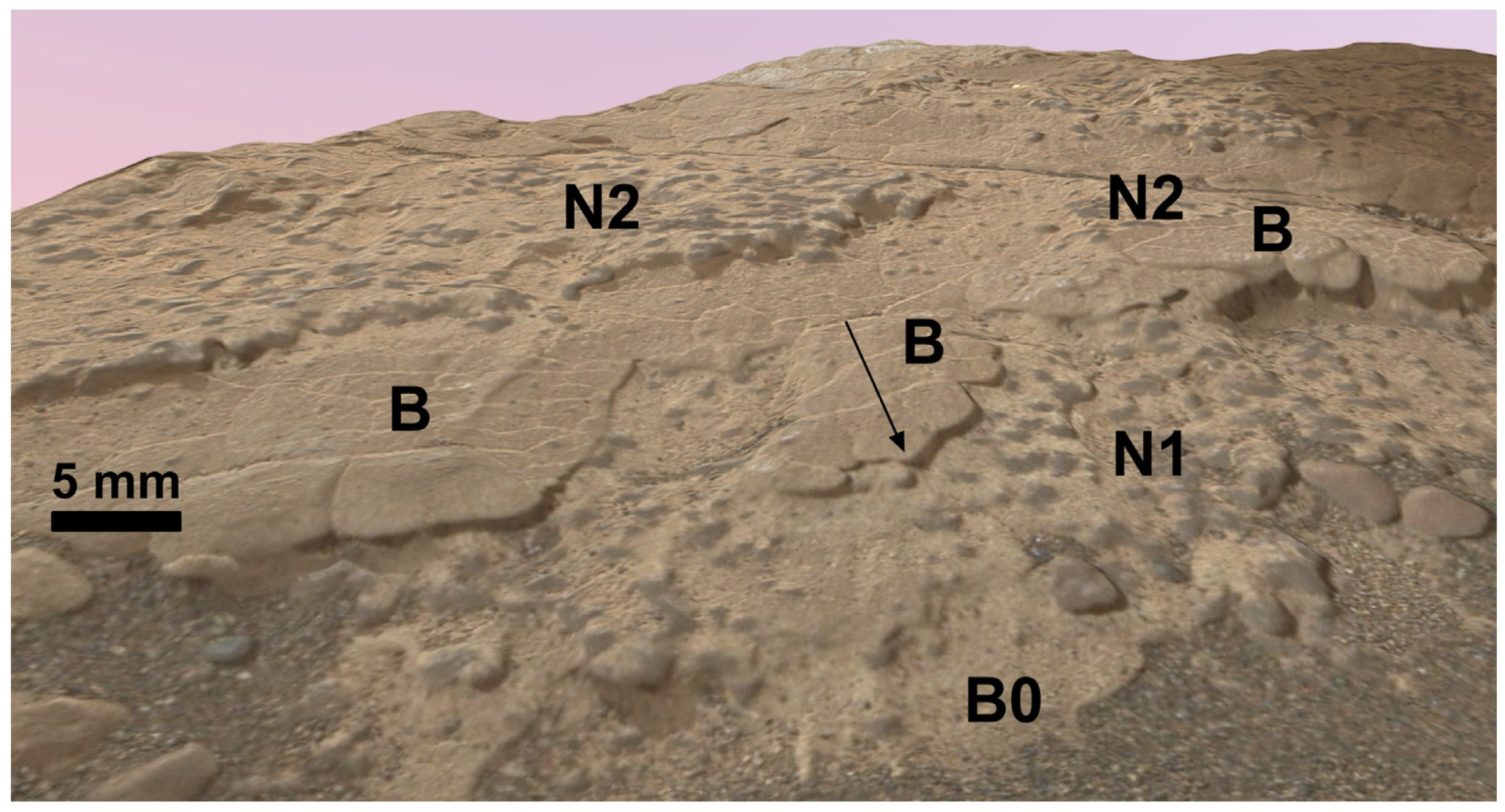
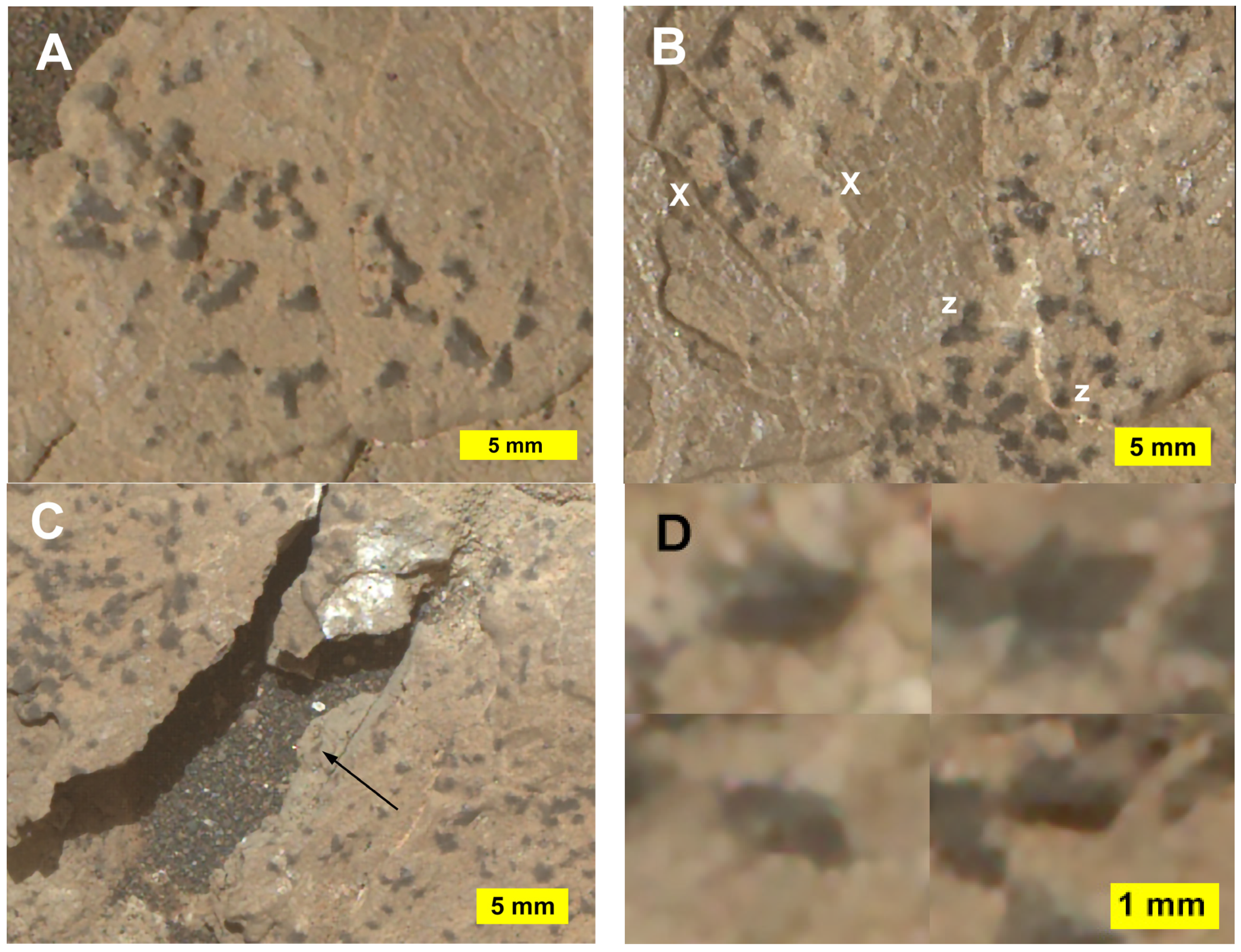
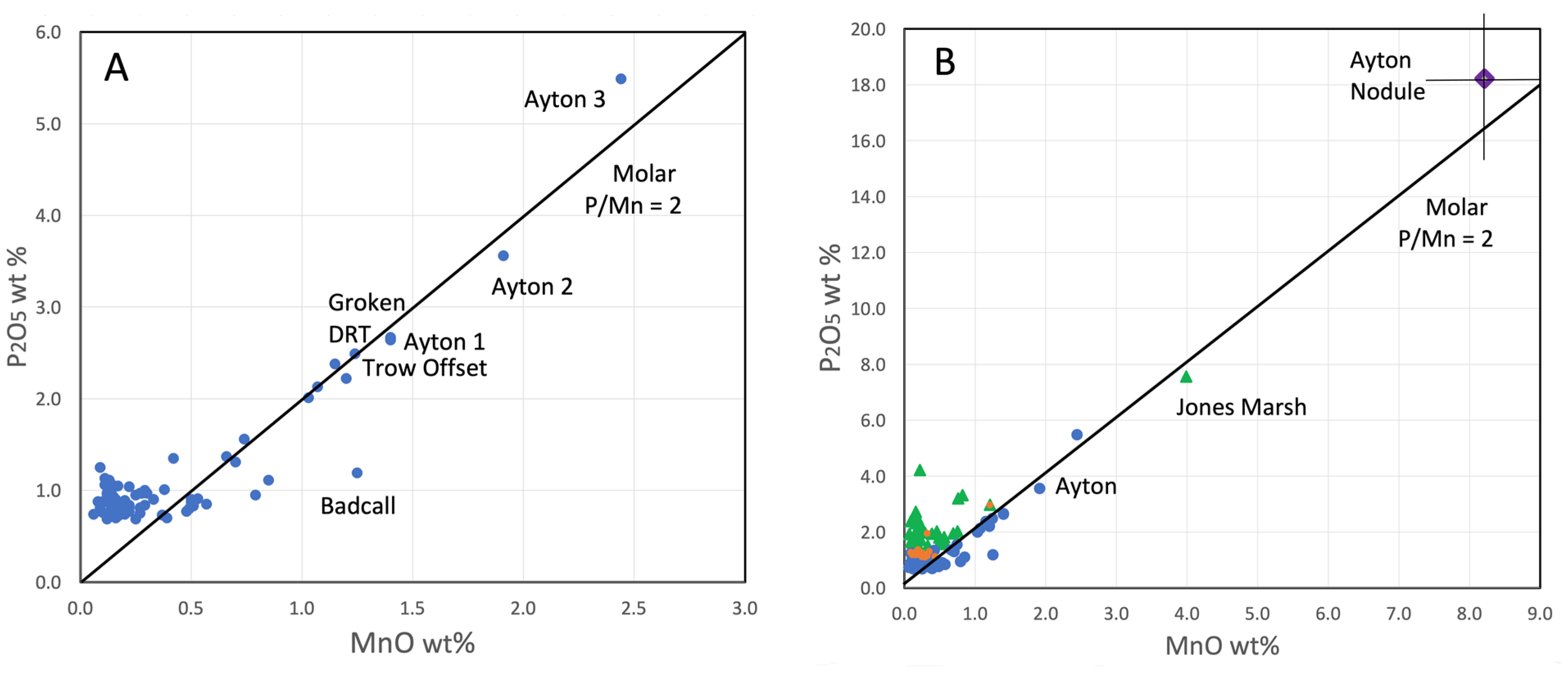
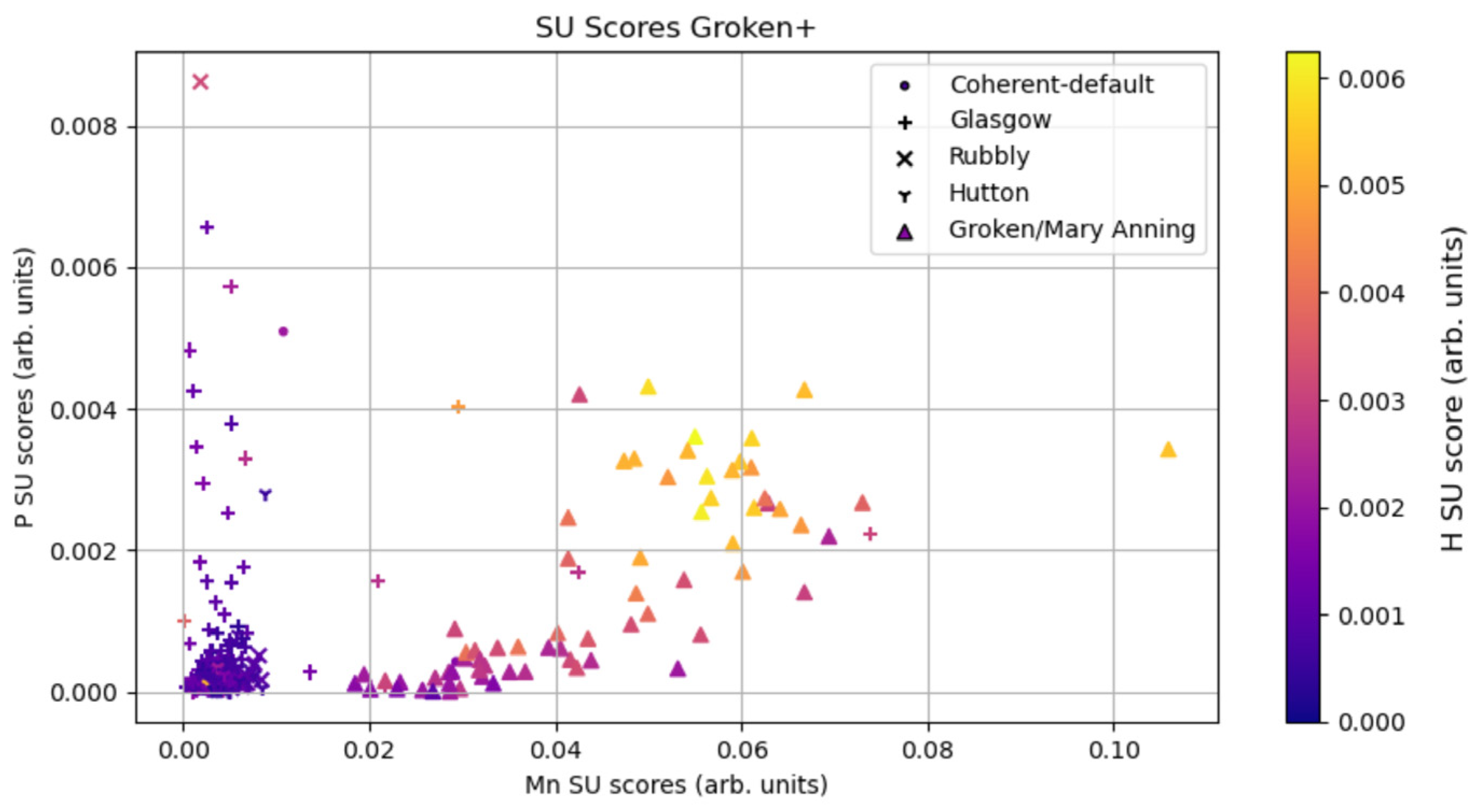
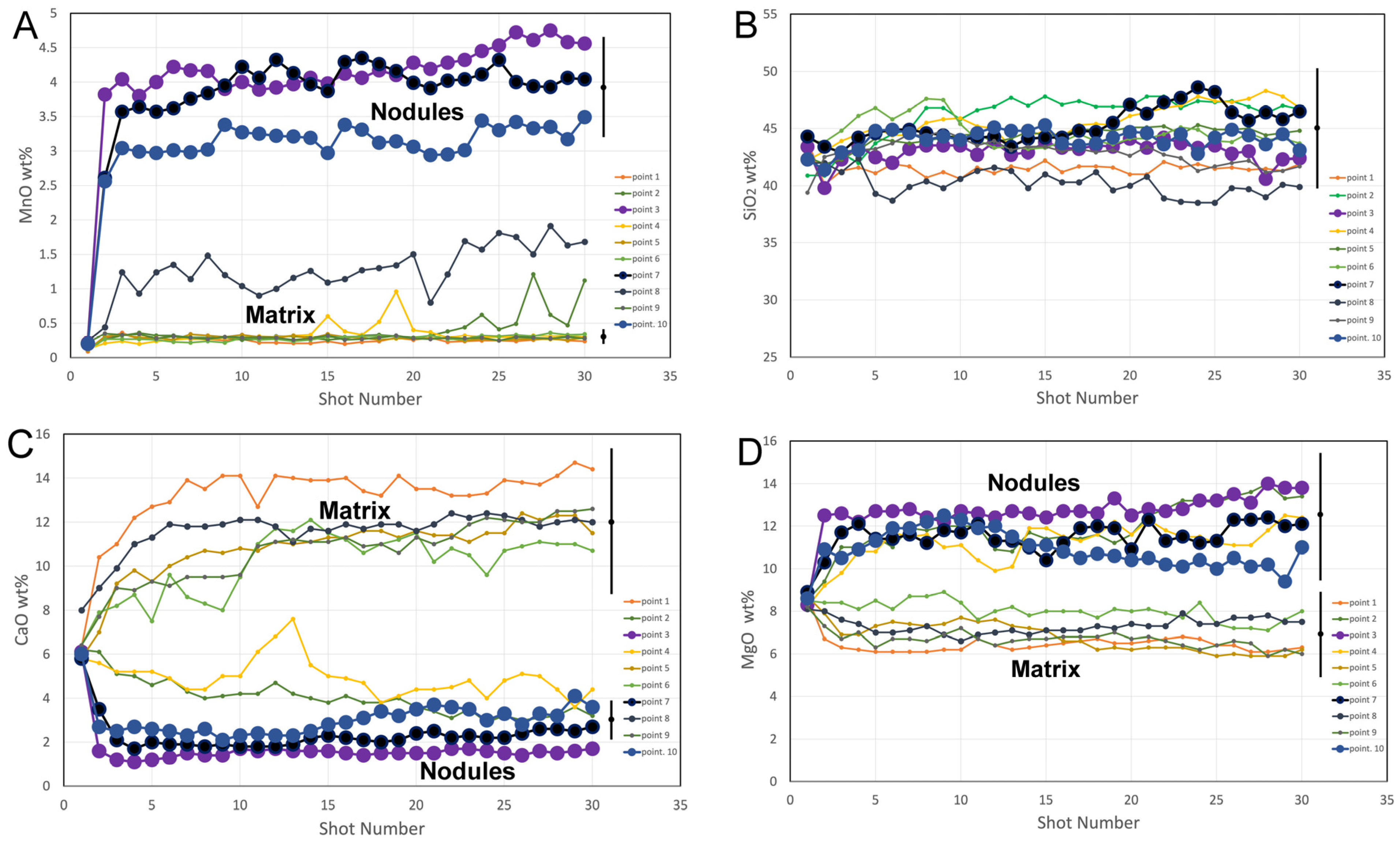
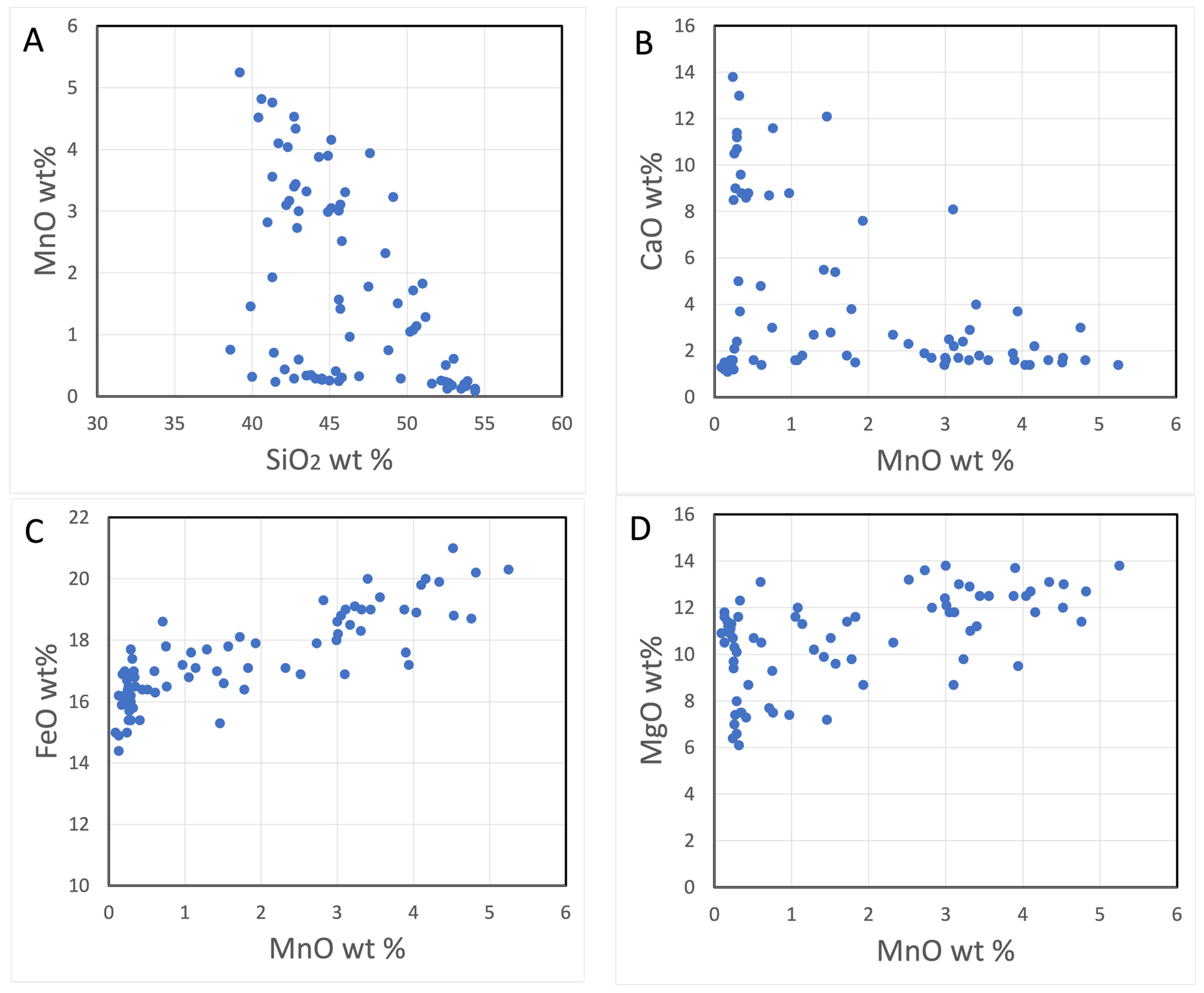
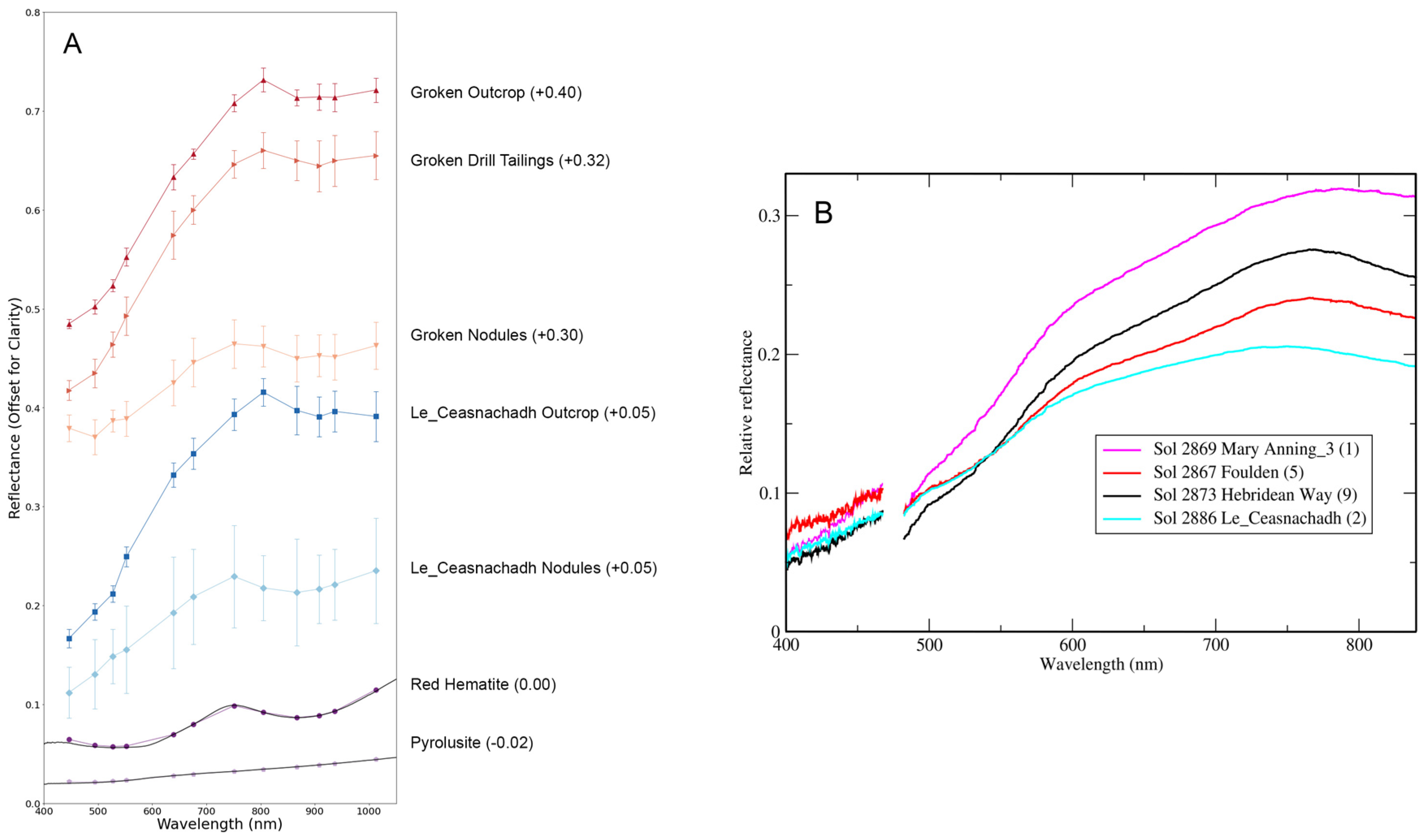
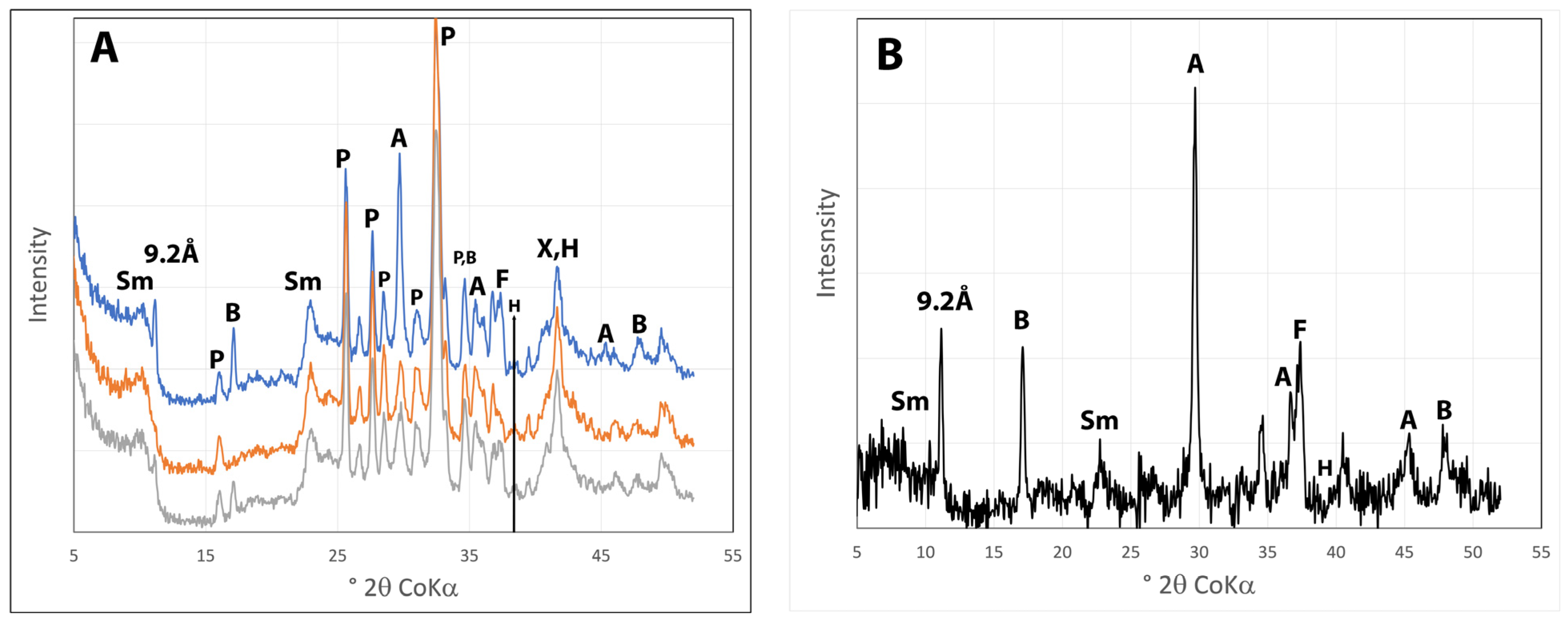
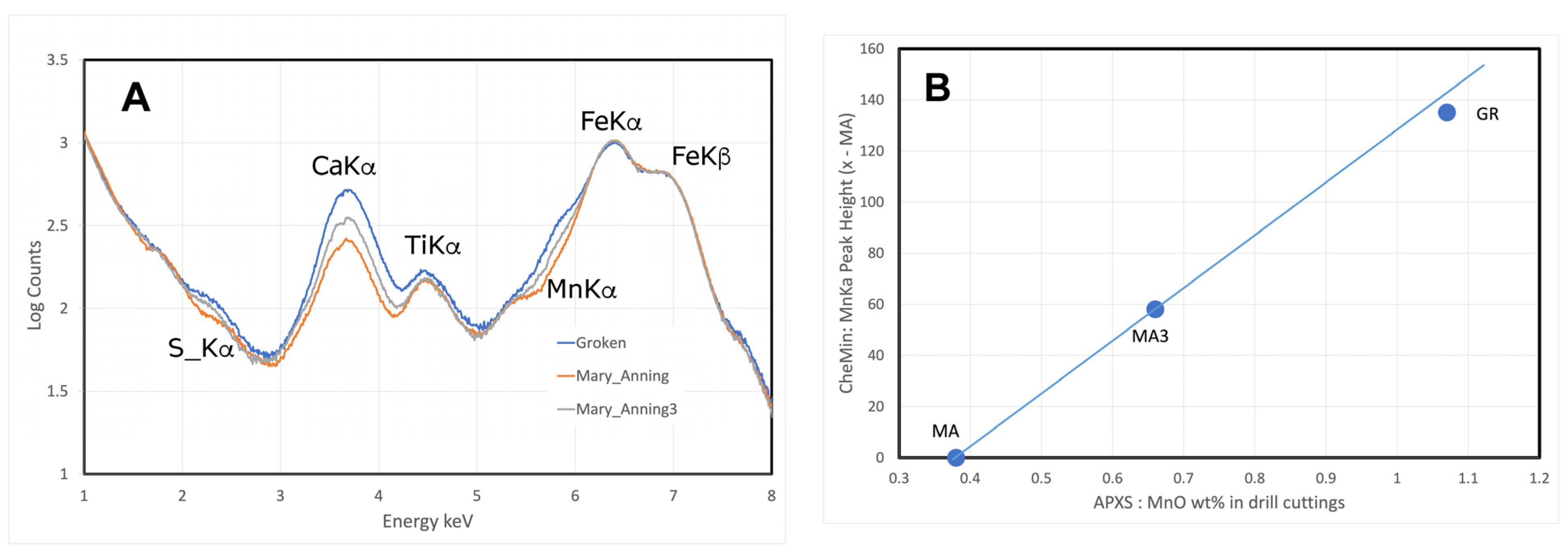
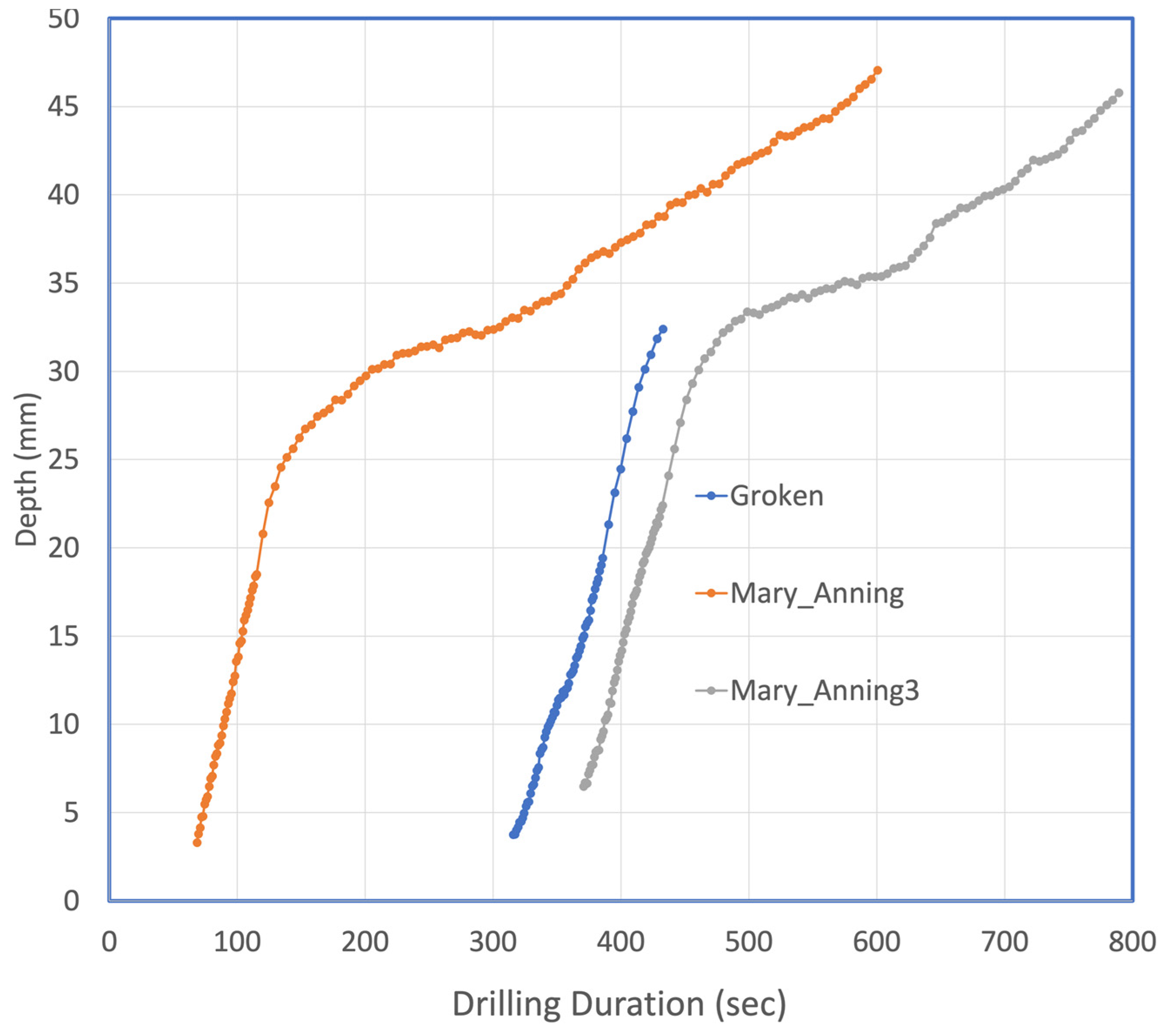
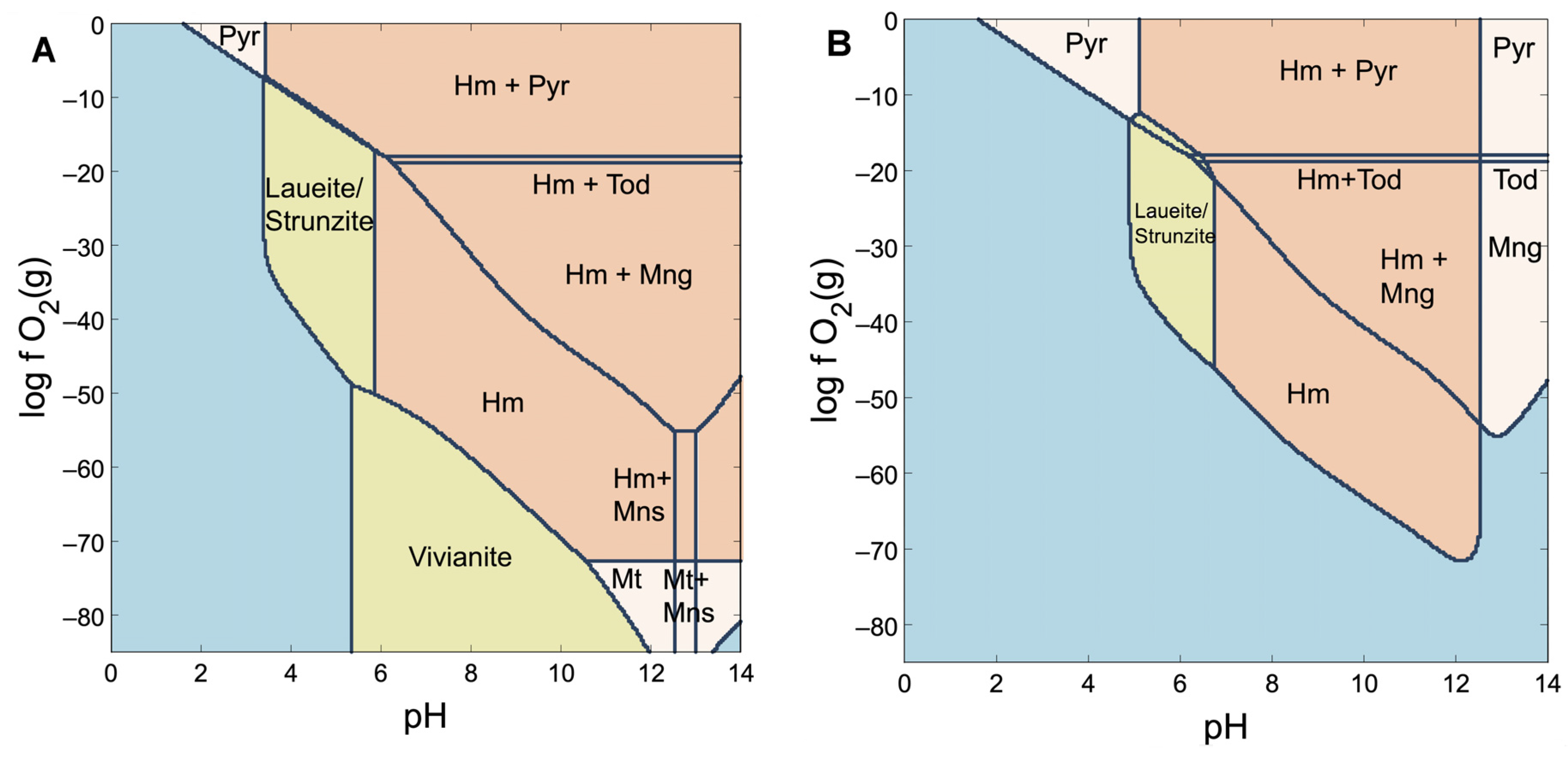
| Composition | Mineral Name | Abundance on Earth |
|---|---|---|
| Mn2+Fe3+2(PO4)2(OH)2·8H2O | Laueite | Rare |
| Mn2+Fe3+2(PO4)2(OH)2·6H2O | Strunzite | Rare |
| Mn2+3(PO4)2·8H2O | Mn-Vivianite | In solid solution with vivianite |
| Mn2+3(PO4)2·3H2O | Reddingite | Rare |
| Mn2+HPO4 | -- | Not known in nature |
| Mn2+3(PO4)2 | -- | Not known in nature |
| Fe2+3(PO4)2·8H2O | Vivianite | Common |
| Fe3+(PO4)·2H2O | Strengite | Rare |
| Fe2+Fe3+4(PO4)3(OH)5 | Rockbridgeite | Rare |
| Fe2+Fe3+2O4 | Magnetite | Common |
| Mn2+Mn 3+2O4 | Hausmannite | Rare |
| Mn2+Fe3+2O4 | Jacobsite | Rare |
| Fe3+2O3 | Hematite | Common |
| Mn2+O | Manganosite | Rare |
| Mn4+O2 | Pyrolusite | Common |
| Fe3+O(OH) | Goethite | Common |
| Mn3+O(OH) | Manganite | Rare |
| Mn3+4Mn4+3O12·3H2O | Todorokite (ideal) | Rare as ideal endmember |
| Deconvolution of Ayton Raster [40] | ||||||
|---|---|---|---|---|---|---|
| Wt % | Mary_Anning2 Offset [26] * | Ayton Raster #3 [26,40] | Groken Offset [26] * | Groken Host Rock | Groken Nodules | Ca-S-Free Nodules |
| Na2O | 2.40 ± 0.14 | 2.62 ± 0.14 | 2.48 ± 0.14 | 2.3 ± 0.3 | 3.2 ± 1.6 | 6.1 ± 3.2 |
| MgO | 6.96 ± 0.17 | 7.59 ± 0.17 | 4.64 ± 0.06 | 7.8 ± 0.2 | 6.7 ± 1.3 | 12.9 ± 2.5 |
| Al2O3 | 8.89 ± 0.19 | 7.84 ± 0.19 | 8.45 ± 0.19 | 9.1 ± 0.2 | 3.7 ± 1.9 | 7.2 ± 3.7 |
| SiO2 | 48.28 ± 0.54 | 36.19 ± 0.43 | 41.73 ± 0.43 | 46.6 ± 1.2 | - | - |
| P2O5 | 0.80 ± 0.05 | 5.49 ± 0.28 | 2.22 ± 0.12 | 1.7 ± 0.6 | 18.2 ± 2.8 | 35.2 ± 5.4 |
| SO3 | 5.31 ± 0.10 | 11.50 ± 0.13 | 11.50 ± 0.17 | 6.2 ± 0.6 | 28.3 ± 5.0 | - |
| Cl | 1.71 ± 0.04 | 1.49 ± 0.02 | 1.57 ± 0.04 | 1.8 ± 0.1 | 0.2 ± 0.3 | 0.4 ± 0.6 |
| K2O | 1.03 ± 0.04 | 0.55 ± 0.02 | 0.67 ± 0.02 | 0.76 ± 0.02 | - | - |
| CaO | 3.19 ± 0.04 | 6.54 ± 0.07 | 4.64 ± 0.06 | 3.6 ± 0.3 | 19.8 ± 2.8 | - |
| TiO2 | 1.11 ± 0.03 | 0.88 ± 0.03 | 1.03 ± 0.03 | 1.14 ± 0.03 | - | - |
| Cr2O3 | 0.34 ± 0.03 | 0.25 ± 0.01 | 0.29 ± 0.01 | 0.37 ± 0.01 | - | - |
| MnO | 0.74 ± 0.03 | 2.44 ± 0.05 | 1.20 ± 0.03 | 1.1 ± 0.2 | 8.2 ± 0.8 | 15.8 ± 1.5 |
| FeO | 17.71 ± 0.20 | 16.27 ± 0.20 | 15.18 ± 0.20 | 17.0 ± 0.1 | 11.6 ± 2.0 | 22.3 ± 3.9 |
| Wt % | Groken_ ccam2 Pt. 1 * | Groken_ ccam2 Pt. 3 | Groken_ ccam2 Pt. 5 | Groken_ ccam2 Pt. 9 * | Groken_ ccam2 Pt. 16 | Groken_ ccam2 Pt. 17 * | Groken_ ccam2 Pt. 20 * | Uncert. Avg. RMSEP |
|---|---|---|---|---|---|---|---|---|
| Na2O | 2.3 | 2.6 | 1.8 | 2.2 | 2.4 | 2.5 | 2.3 | 0.6 |
| MgO | 13.0 | 9.3 | 7.5 | 9.9 | 10.1 | 10.7 | 12.7 | 2.8 |
| Al2O3 | 8.5 | 11.7 | 9.5 | 9.2 | 10.7 | 10.8 | 7.9 | 3.4 |
| SiO2 | 43 | 49 | 44 | 46 | 50 | 49 | 41 | 5 |
| P2O5 | ! | ! | ! | |||||
| K2O | 0.4 | 0.6 | 0.4 | 0.5 | 0.5 | 0.5 | 0.3 | 0.6 |
| CaO | 1.7 | 3.0 | 9.6 | 5.5 | 2.4 | 2.8 | 1.6 | 1.2 |
| TiO2 | 0.9 | 0.8 | 0.8 | 0.85 | 1.22 | 0.9 | 0.8 | 0.45 |
| MnO | 4.5 | 0.8 | 0.3 | 1.4 | 0.3 | 1.5 | 4.8 | 0.1/0.7 |
| FeO | 18.8 | 17.8 | 16.8 | 17.0 | 17.7 | 16.6 | 20.2 | 3.8 |
| Total | 93 | 96 | 90 | 92 | 95 | 96 | 91 | - |
| Mineral | Formula | Setting on Earth 2 |
|---|---|---|
| Laueite | P F L W V(?) | |
| Stewartite | Mn2+Fe3+2(PO4)2(OH)2·8H2O | P |
| Pseudolaueite | P | |
| Strunzite | Mn2+Fe3+2(PO4)2(OH)2·6H2O | P F L W |
| Earlshannonite | Mn2+Fe3+2(PO4)2(OH)2·4H2O | P |
| Wilhemvierlingite | CaMn2+Fe3+(PO4)2(OH)·2H2O | P |
| Fairfieldite | Ca2Mn2+(PO4)2·2H2O | P W |
Disclaimer/Publisher’s Note: The statements, opinions and data contained in all publications are solely those of the individual author(s) and contributor(s) and not of MDPI and/or the editor(s). MDPI and/or the editor(s) disclaim responsibility for any injury to people or property resulting from any ideas, methods, instructions or products referred to in the content. |
© 2023 by the authors. Licensee MDPI, Basel, Switzerland. This article is an open access article distributed under the terms and conditions of the Creative Commons Attribution (CC BY) license (https://creativecommons.org/licenses/by/4.0/).
Share and Cite
Treiman, A.H.; Lanza, N.L.; VanBommel, S.; Berger, J.; Wiens, R.; Bristow, T.; Johnson, J.; Rice, M.; Hart, R.; McAdam, A.; et al. Manganese-Iron Phosphate Nodules at the Groken Site, Gale Crater, Mars. Minerals 2023, 13, 1122. https://doi.org/10.3390/min13091122
Treiman AH, Lanza NL, VanBommel S, Berger J, Wiens R, Bristow T, Johnson J, Rice M, Hart R, McAdam A, et al. Manganese-Iron Phosphate Nodules at the Groken Site, Gale Crater, Mars. Minerals. 2023; 13(9):1122. https://doi.org/10.3390/min13091122
Chicago/Turabian StyleTreiman, Allan H., Nina L. Lanza, Scott VanBommel, Jeff Berger, Roger Wiens, Thomas Bristow, Jeffrey Johnson, Melissa Rice, Reginald Hart, Amy McAdam, and et al. 2023. "Manganese-Iron Phosphate Nodules at the Groken Site, Gale Crater, Mars" Minerals 13, no. 9: 1122. https://doi.org/10.3390/min13091122
APA StyleTreiman, A. H., Lanza, N. L., VanBommel, S., Berger, J., Wiens, R., Bristow, T., Johnson, J., Rice, M., Hart, R., McAdam, A., Gasda, P., Meslin, P.-Y., Yen, A., Williams, A. J., Vasavada, A., Vaniman, D., Tu, V., Thorpe, M., Swanner, E. D., ... Anderson, R. (2023). Manganese-Iron Phosphate Nodules at the Groken Site, Gale Crater, Mars. Minerals, 13(9), 1122. https://doi.org/10.3390/min13091122











